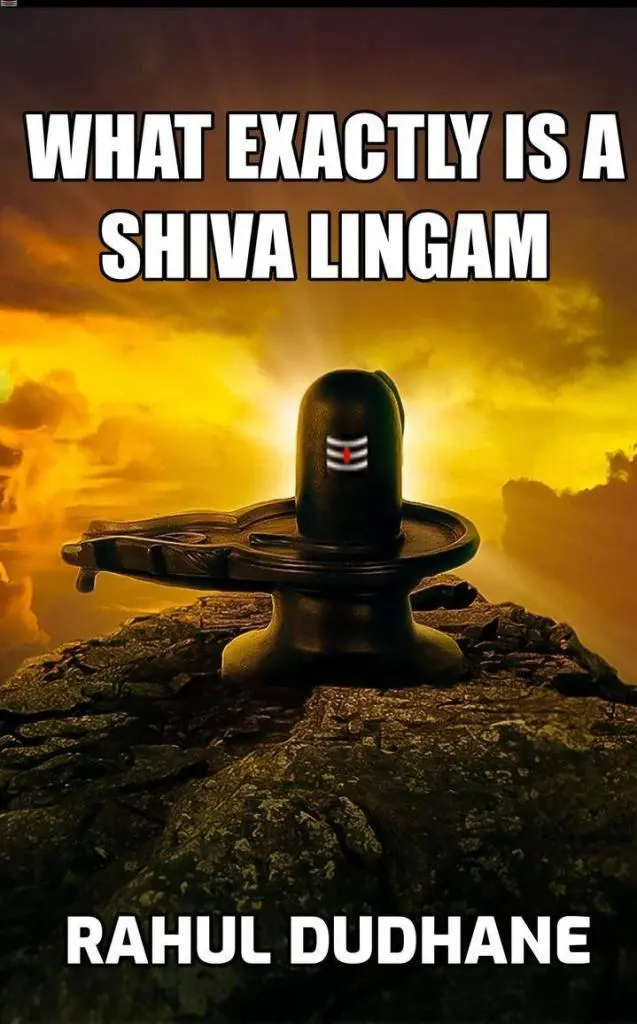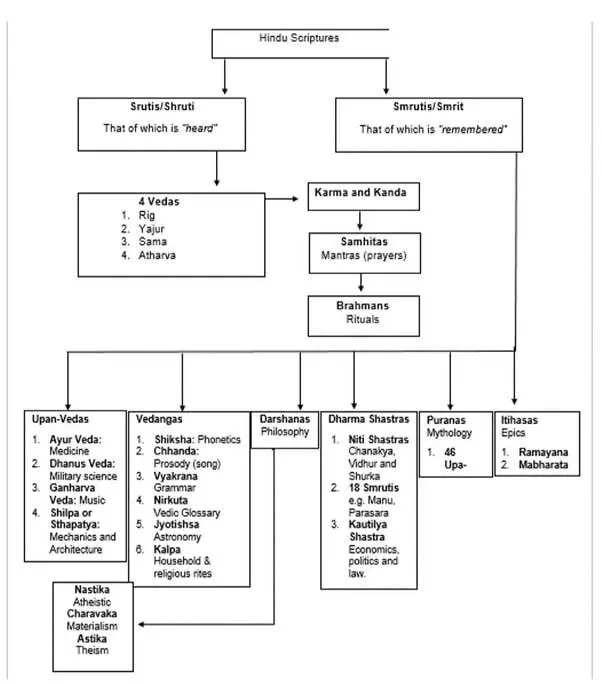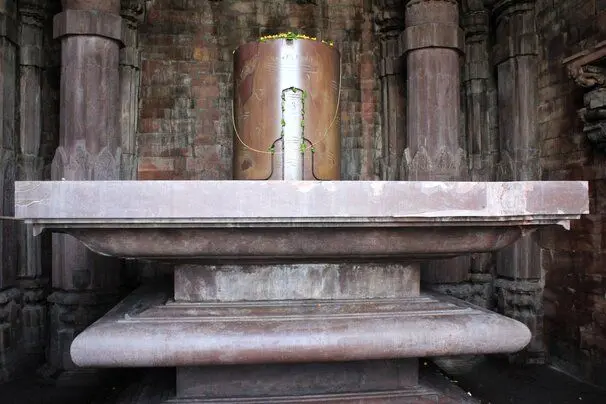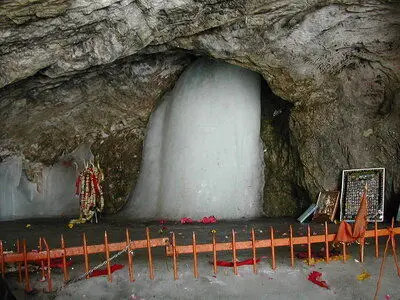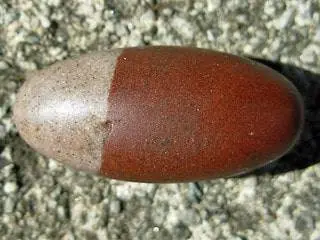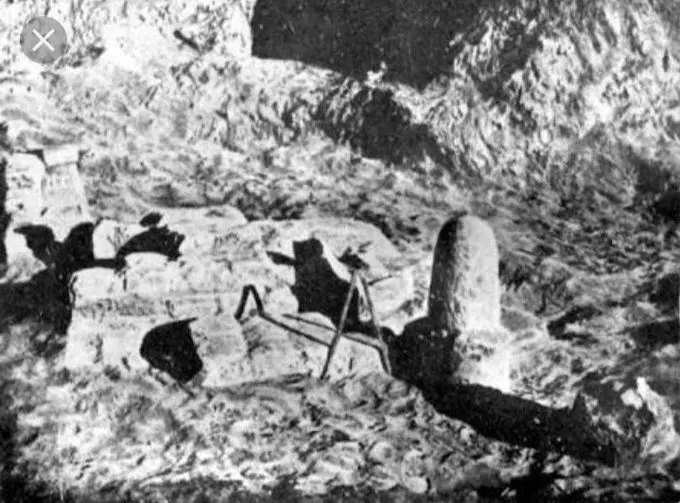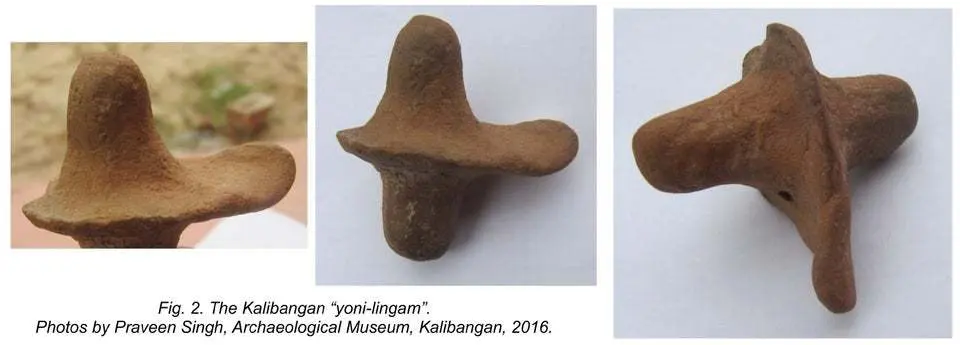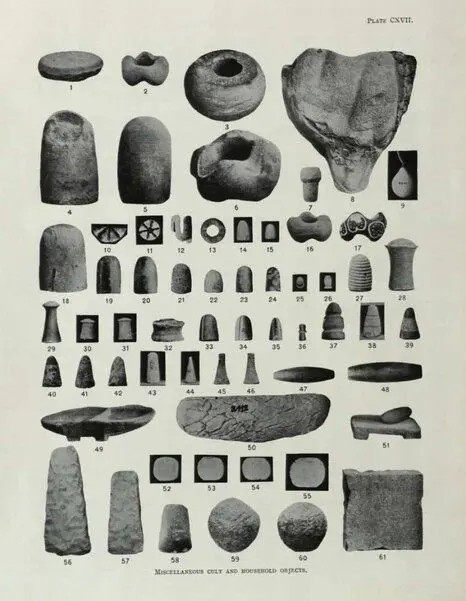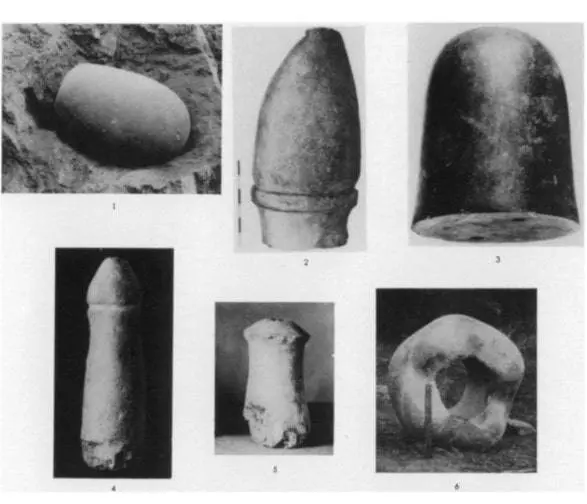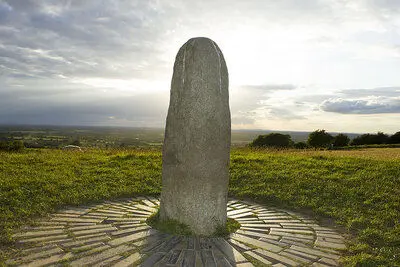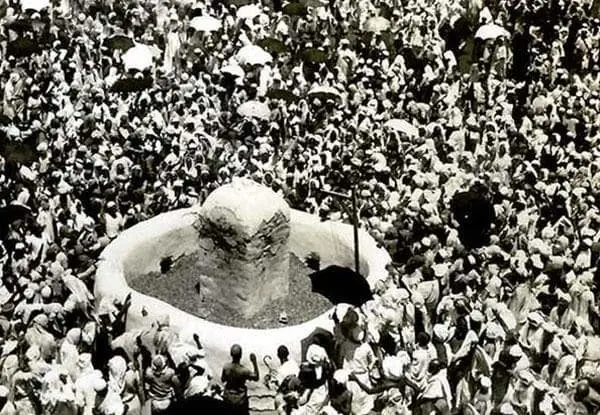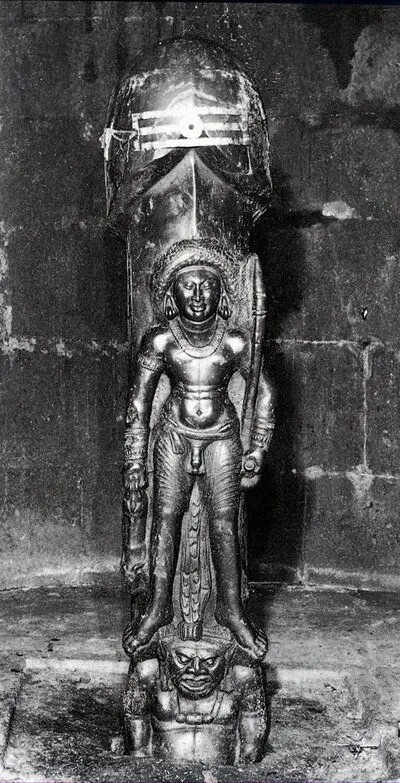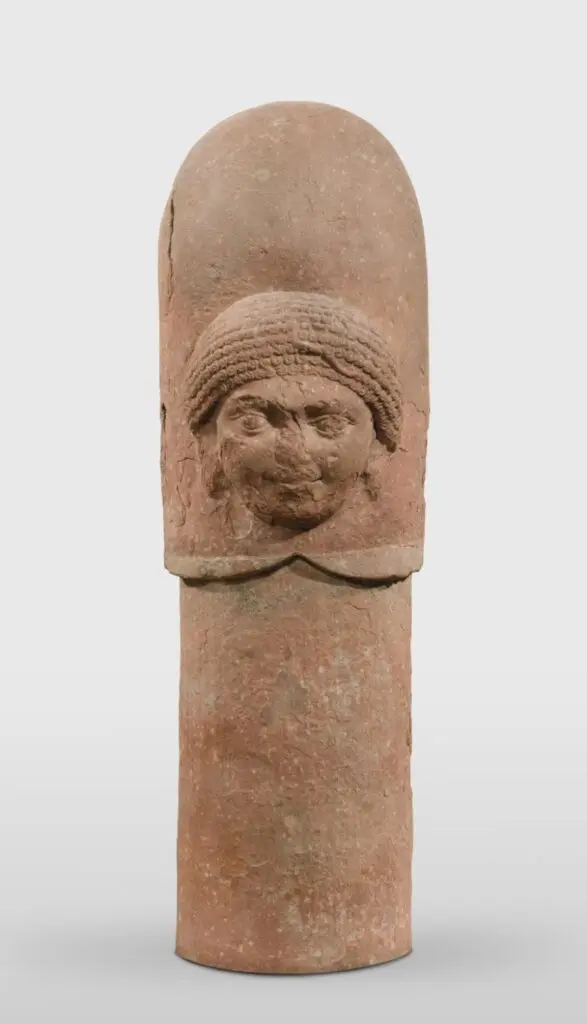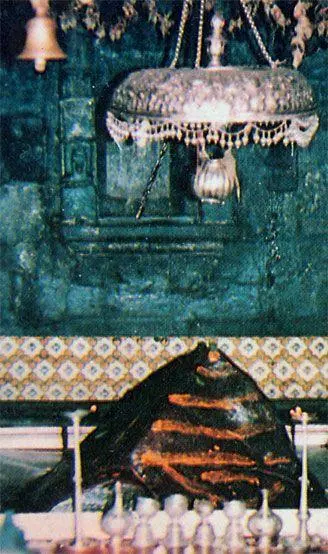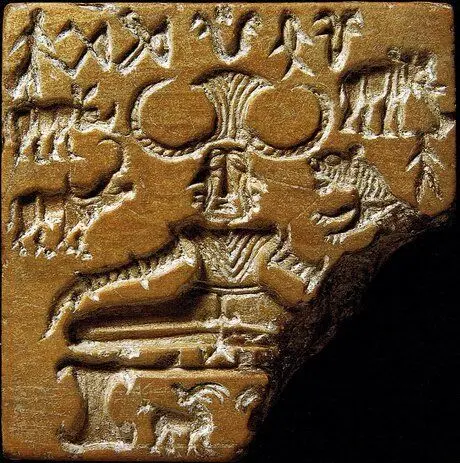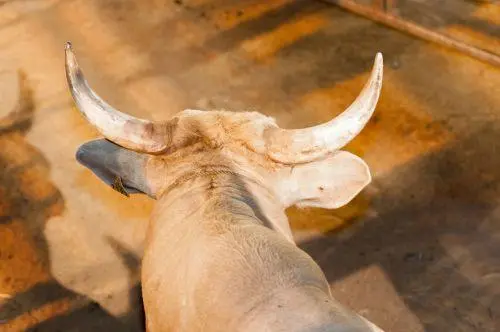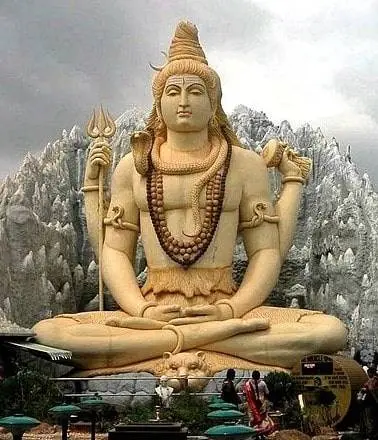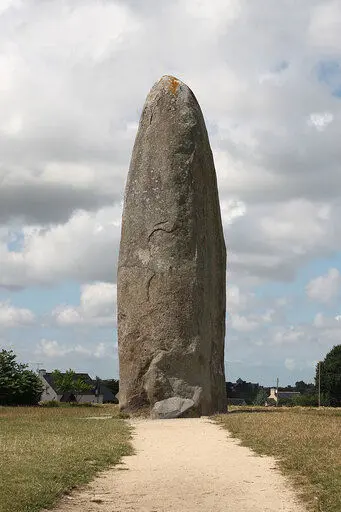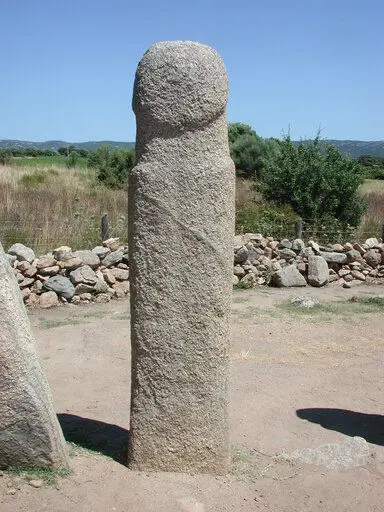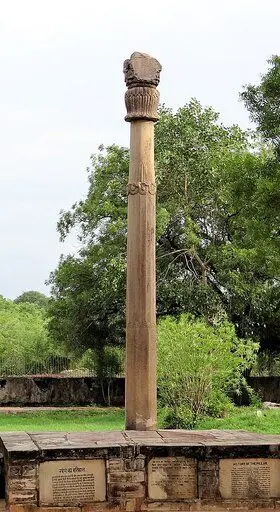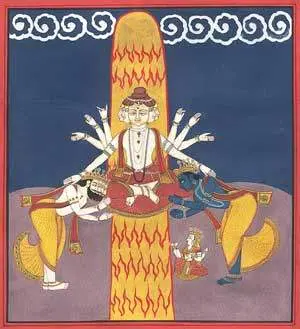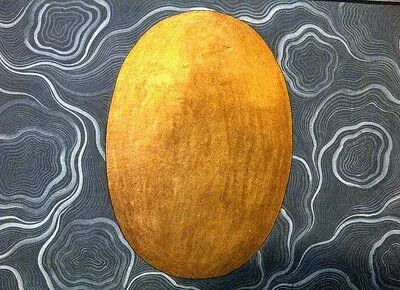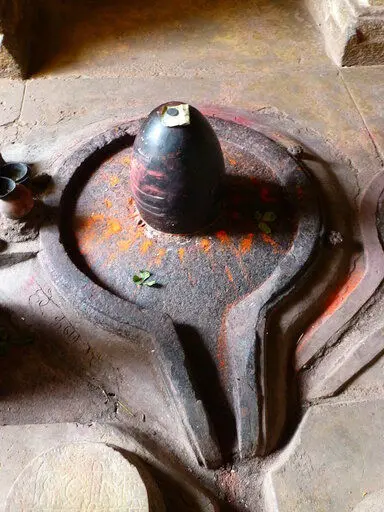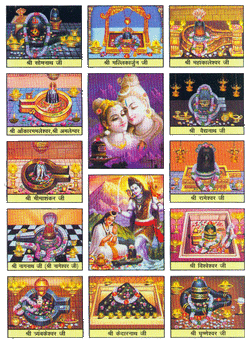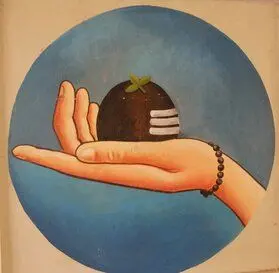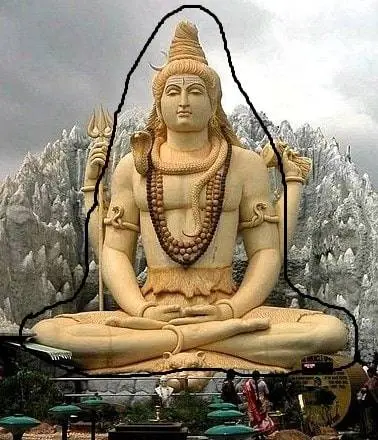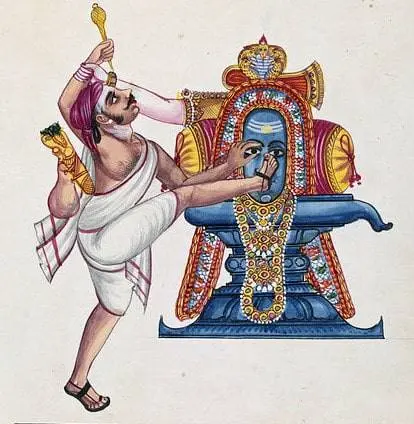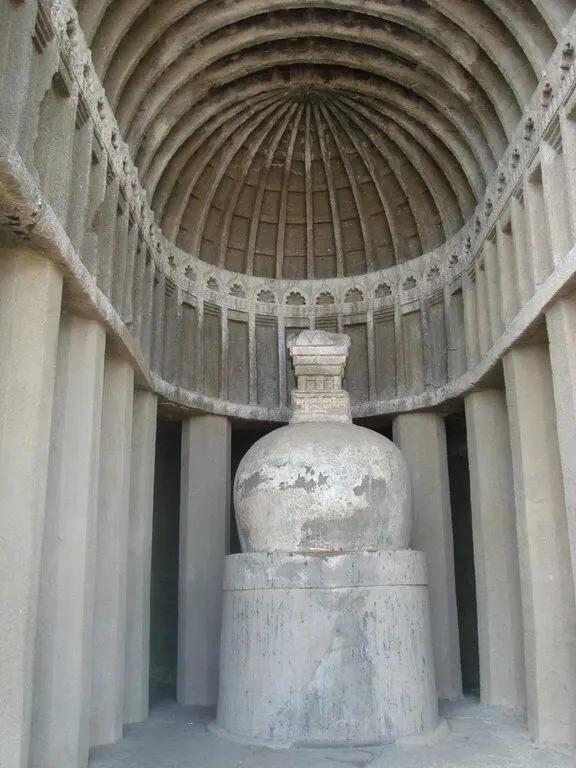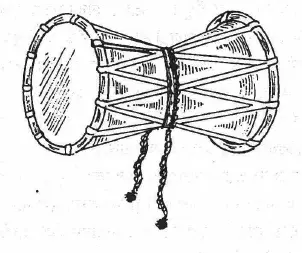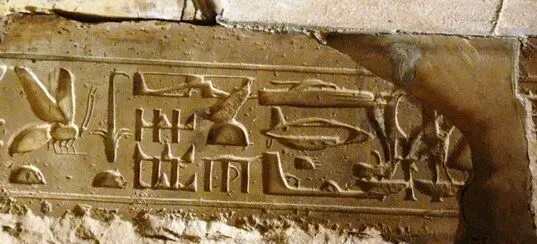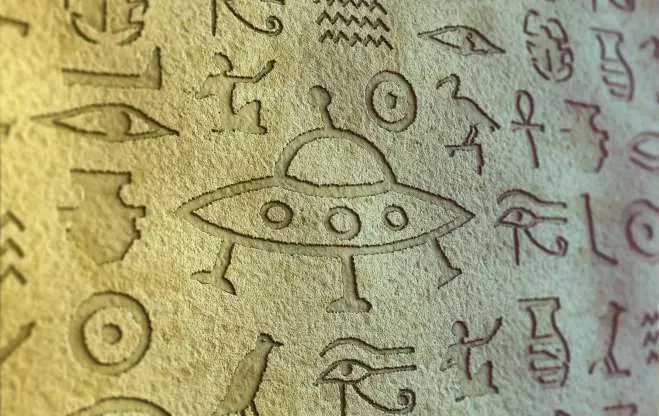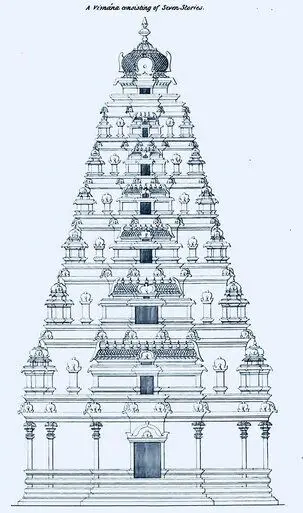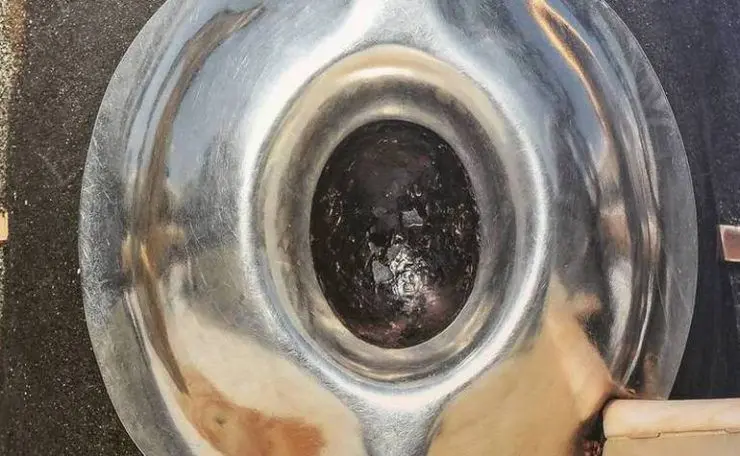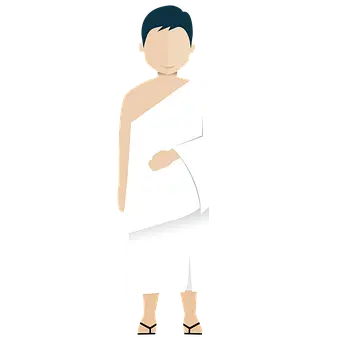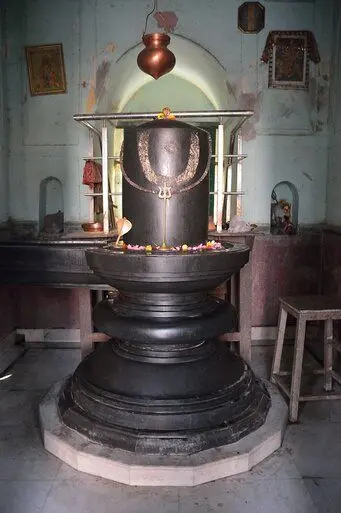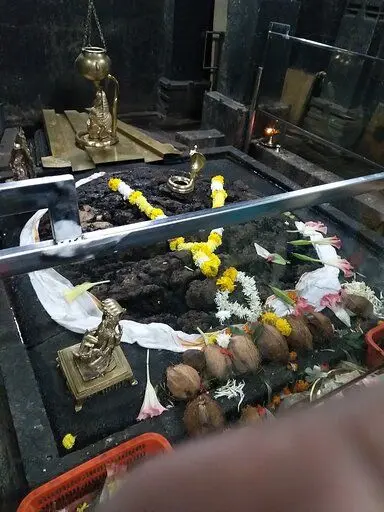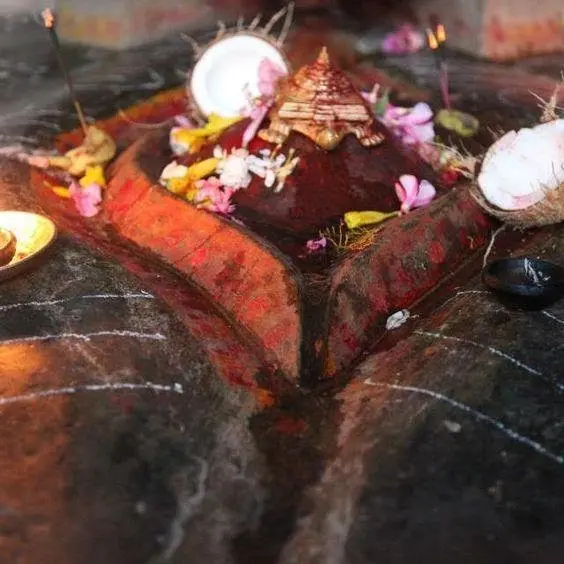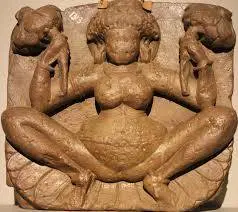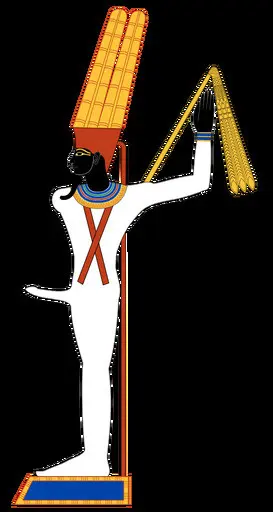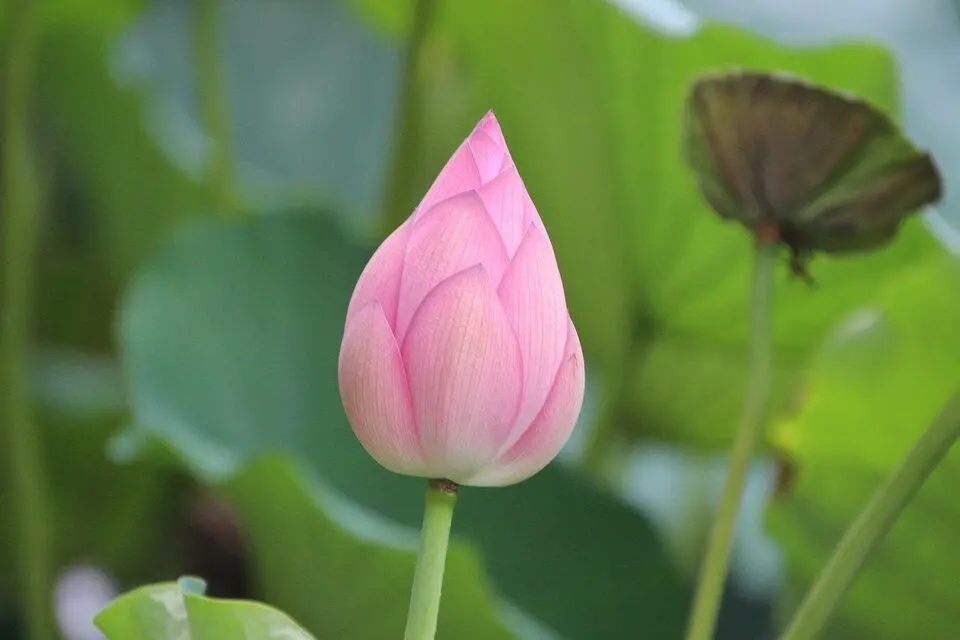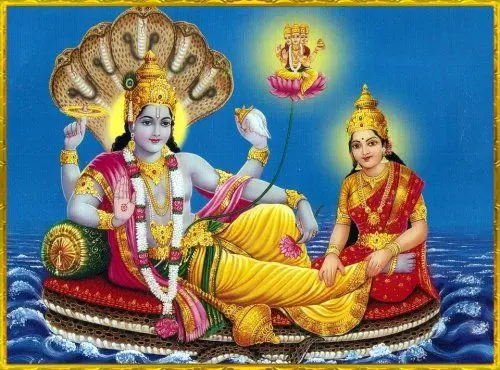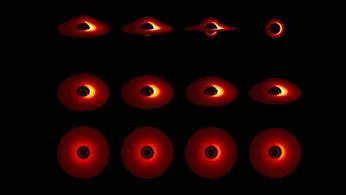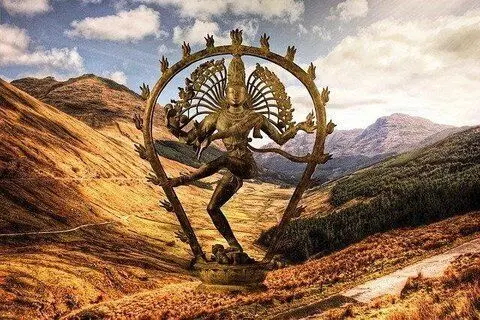“What Exactly Is A Shiva Lingam?” is a free e-book that answers most of the questions about a Shiva lingam. This page takes a long time to load as it is a full book. If you don’t have time to read the full book, you can go directly to the conclusion section. This book is available for free on Google Play. Click here to read it for free on Google Play.
______________________________________________________________________________________________
Copyright and Disclaimer
No part of this book may be reproduced, stored in a retrieval system, or transmitted in any form or by any means, electronic, mechanical, photocopying, recording, or otherwise, without the prior written permission of the author except for the material already in the public domain or for the inclusion of brief quotations for research or review. The views expressed in this book are those of the authors.
The author is not liable for any loss or damage resulting from the use of information presented in this book. The author does not make any representation or warranty with respect to the accuracy or completeness of the information presented in this book.
© 2021 Rahul Dudhane. All rights reserved.
Email: [email protected]
______________________________________________________________________________________________
Dedicated To
Sage Vyasa
Who Left for us the Treasure of Knowledge
______________________________________________________________________________________________
“Truth is one; wise men speak of it variously.”
– Rigveda
______________________________________________________________________________________________
Preface
When I was a kid, there was a temple of Lord Shiva near my house with a Shiva lingam installed in it. I used to go there intermittently. At that time, I did not know its meaning. I just knew that it was an idol of Lord Shiva, who is a very powerful god and is capable of destroying the whole world if he opens his third eye. Actually, I was scared of him. In my adolescence also, I did not know much about it, but I had a faint idea what it could be because the word linga is used mainly to denote a sexual organ or gender in India, but I never talked about it with anyone.
When I grew young, one day I heard my mom whispering to someone about it being the sexual organs of Lord Shiva and Goddess Parvati. It was the first time I came to know about one of the meanings of the Shiva lingam. At that time, I wondered how we could worship sexual organs even if they are of divine personalities, but then I forgot about it and continued to be a devotee, as it did not make a difference.
Then in the book “The Da Vinci Code,” I read that the Shiva lingam is a symbolic representation of feminine and masculine principles, and so is the Star of David of Jews and other things in different cultures. From then, my perception of looking toward it changed. Then when the popularity and availability of the Internet increased in India and I started exploring Hinduism online as it is my favorite topic, I found that there were many misconceptions about Hinduism among Hindus, and most of them were not aware of real Hinduism, including me. E.g., until then, I did not know that Brahman is the supreme God in Hinduism. I just knew that the Hindu trinity is the most powerful god.
Therefore, I started a website named www.hinduismfacts.org to spread the word about Hinduism and also to learn new things about it. I learned many new things about it in due course, but I did not pay much attention to the Shiva lingam at that time. Also, I was working at that time and was quite busy. Therefore, it was difficult to dedicate a lot of time to this topic. In the year 2017, due to some health issues and other problems, I had to leave my job and got abundant time but was still involved in some other things. In the year 2020, I discovered that my real passion was studying Hinduism, and I was wasting my time on the things that I did not like much. Therefore, I decided to spend most of my time studying Hinduism in-depth but did not know where to start because Hinduism is so vast that even a lifetime is insufficient.
It was when I came across some arguments on Quora about the Shiva lingam, and I decided that my first topic for research would be the Shiva lingam. Also, I am a devotee of Lord Shiva, so it was a good place to start. Initially, I thought it would be easy to find out what it really is, but as I went on collecting more information about it, I understood that I was wrong. I had never thought of the conclusion that I arrived.
This book is actually a part of my quest that I am sharing with you. I know some of you would agree with my perspective and some would not, but I have tried my best to give answers that would satisfy the queries of people with different perspectives.
– Mr. Rahul Dudhane
______________________________________________________________________________________________
Must Read
To understand the real meaning of the Shiva lingam, first, we need to understand what Hinduism is and what makes the beliefs of Hindus.
Hinduism is a conglomeration of different doctrines and traditions, mainly based on the Vedas, and modified from time to time by great sages and saints without changing its core teachings. The set of beliefs that Hindus have are not only rooted in the Vedas, but also the Puranas, agamas, epics like the Ramayana and Mahabharata, and other numerous religious literature and folktales. Astrology also plays an important role in a Hindu’s life. These beliefs vary from region to region, sects to sects, and castes to castes. The upbringing of a person also plays an important role. E.g., a highly educated Hindu tries to find science in the customs and traditions, a spiritual Hindu tries to find spiritual meanings in them, while a less educated one would look at the things as they look like and will not question the faith.
The current form of Hinduism that is practiced by most of the Hindus is Puranic because most of the Hindu beliefs have their roots in the Puranas.
Archaeology is also an important factor to understand the meaning of the Shiva lingam, but it has its own limitations. There could be many things hidden in the womb of the Earth that are yet to be unraveled. Also, there are some things that governments do not reveal because of sociopolitical reasons. E.g., the excavation at the Dwaraka site in Gujarat was stopped suddenly without any valid reason. This site is actually one of the most important archaeological sites in India. Therefore, archaeology alone cannot be a decisive factor, but it would certainly help us arrive at a unanimous decision.
Mostly, when it comes to religious matters, we rely more on the scriptures than other things, but what if there are contradictions among the scriptures? Then, we have to consider the authoritativeness of the scriptures.
Hindu scriptures are divided mainly into two categories, viz. Shruti and Smriti.
A. Shruti: It means “that which is heard.” The texts in this category are considered more authoritative because they are believed to be revealed by God and heard by humans (different sages in deep meditation). It consists of four Vedas.
1. Rigveda.
2. Yajurveda.
3. Samaveda.
4. Atharvaveda.
Each of these Vedas includes Upanishads, Samhitas, Brahmanas, and Aranyakas. Among the four Vedas, the Rigveda Samhita is the oldest and the most authoritative text.
B. Smriti: It means “that which is remembered.” The texts in this category are less authoritative than the Shruti texts because they are considered a derivative/secondary work.
It consists of a large number of texts, including but not limited to Vedangas, the Ramayana and Mahabharata, Dharmasutras and Dharmashastras, Arthashastras, Puranas, poetic literature, and commentaries on various texts.
Broadly speaking, Shruti texts are esoteric, and Smriti texts are for common people.
Image – Classification of Hindu texts
Credit: Quora
Smriti texts try to explain elaborately what is written in the Vedas. Many stories in the Puranas are expansions of the hymns in the Vedas.
We have to consider folktales also as they play an important role to form religious beliefs.
The main problem before us is that nothing is mentioned in the Shruti texts about the Shiva lingam. Rudra in the Vedas becomes Lord Shiva in the Puranas. Therefore, we have to largely rely on the Puranas, the Ramayana, and the Mahabharata, especially the Puranas as they contain stories before the Ramayana and the Mahabharata and a lot of information related to the Shiva lingam.
In ancient times, knowledge was transmitted orally from generation to generation. When historians say that a particular book was written in a particular year, they are actually talking about the first written copy of that book that was found. There could be many older copies of that book that are not either found yet or succumbed to time or maybe, that book was just transmitted orally for thousands of years before being written. Therefore, even if modern historians believe that the Puranas were written around 300-400 CE, Hindus believe that they are millions of years old!
The current versions of the Puranas are believed to be compiled by the disciples of Sage Vyasa. The word Vyasa literally means “compiler.” Vyasa is not a name but a designation. Hindus believe that in every yuga, a Vyasa is born who compiles the ancient knowledge and passes it to future generations in a systematic way. The original name of Sage Vyasa, that we are talking about, is Krishna Dvaipayana. It is believed that he acquired this knowledge from Lord Brahma, Sage Narada, and Sanat Kumaras.
Sage Vyasa compiled the original Purana Samhita (collection of mantras) and gave it to his disciple, Lomaharshana, who imparted it to his disciples. The three of them created their own Samhitas. These three and the original one comprise the Mulasamhita, from which the later 18 Puranas were derived. Therefore, the Puranas could date back to around 3200-3100 BCE that is about 5000 years old. It is believed that originally, there were one crore (10 million) shlokas in them, but now there is only 4.5 lakh (0.45 million).
These Puranas were further updated by other sages. That is why there are many contradictions in them. This problem is not unique to Hindu scriptures. There are many contradictions in the Bible also.
The Puranas are polytheistic as well as henotheistic in nature. They proclaim that Brahman is the Supreme God, but seem confused when it comes to who is greater between Lord Shiva and Lord Vishnu. Different stories in them depict how Lord Shiva is greater than Lord Vishnu and vice versa. We can see a clear competition between the devotees of Lord Shiva and Lord Vishnu.
Among the 18 Mahapuranas, the Linga Purana is dedicated to the Shiva lingam. Hence, we should consider it more authoritative than other Puranas (only in terms of the Shiva Lingam), but it does not mean that we should completely overlook other texts.
Another problem is the language. All the major Hindu scriptures are written in Sanskrit, and most of the Hindus do not understand it. Therefore, one has to rely mainly on translations. Many of these translations are done by foreigners, and the word linga is translated as “phallus” mostly. Hindu scholars also have followed the same path. Therefore, anyone who reads these scriptures does not even think that there could also be other meanings of the Shiva lingam.
Most of the stories in Hindu scriptures are allegorical. Especially with the advancement in science and technology, the new generation of Hindus strongly believes that all these stories contain a lot of scientific knowledge that needs to be deciphered. E.g., the ten stories of Dashavatara (ten incarnations of Lord Vishnu) can be interpreted in different ways, like:
A. Literally, Lord Vishnu took ten incarnations and restored dharma.
B. Symbolically, these ten incarnations depict important stages in evolution.
1. Matsya (part-fish and part-man) – Animals in water like fish are born.
2. Kurma (tortoise) – Amphibious animals are born.
3. Varaha (part wild boar and part-man) – Herbivorous animals are born.
4. Narasimha (part-lion and part-man) – Carnivorous animals are born.
5. Vamana (dwarf) – Humans are born. Humans used hands and feet for moving from one place to another. Humans started walking on their feet.
6. Parashurama (the man with an ax) – Humans started using iron (Iron Age).
7. Rama (the man with a bow and arrows) – Humans started using semi-modern weapons like bow and arrow. They also developed a conscience and became more civilized.
8. Krishna (a clever man with Sudarshana Chakra) – People became shrewd and started using more advanced weapons (heralding Kali Yuga).
9. Buddha (who has attended wisdom) – Humans became enlightened or got supreme knowledge.
10. Kalki – Very advanced human beings, both technologically and genetically.
Some people might argue that the association between Dashavatara and evolution is pseudoscience, but this is not the exception, there are many stories in the Hindu scriptures that prove that these stories contain a lot of scientific knowledge that was passed on to the next generation through stories.
Hindu sages had the knowledge of science, but they also knew that if it falls in the wrong hands, it could prove self-destructive. To prove my point, I have given more examples in the Chapter “Shiva Lingam as a Science Symbol.”
Therefore, in our quest to find out what the Shiva lingam is, we have to consider all those things.
The word scripture has two meanings, one of which is sacred texts. Here, I have used the word scripture as “a holy text.”
______________________________________________________________________________________________
1. Introduction
Image 1.1 – The Shiva Lingam at Bhojpur Temple in Madhya Pradesh
Image Credit: Vijay Tiwari09 (licensed under CC-BY-SA 4.0)
A Shiva linga, also known as Shiva lingam or Shivling, is a short cylindrical pillar-like structure that is rounded on top and fixed on a circular base with a vent. Usually, it is made of a black granite stone. It is one of the most worshiped idols as it is a symbol of Lord Shiva, who is a very popular Hindu god.
There are thousands of temples of Lord Shiva in the world, where people worship him in the form of a Shiva lingam. The most famous of them are 12 Jyotirlinga temples and Amarnath cave in India. Thousands of liters of milk are poured daily on Shiva lingams across the world to please Lord Shiva. In Hinduism, there is a subsect of Shaivism known as Lingayatism (Lingayats believe theirs is a separate sect/religion), the followers of which worship Shiva in the form of a lingam only and wear it in a necklace.
Most of the Hindu houses contain altars where you would find a Shiva lingam. There are many stories related to it in the Hindu scriptures.
Shiva lingams are found in many parts of the world, including but not limited to India, China, Japan, Vietnam, Ireland, Italy, South Africa, Indonesia, Nepal, Sri Lanka, and Thailand.
The common notion about it is that physically it is a union of private parts of Lord Shiva and Goddess Parvati, and symbolically, it represents the masculine (Purusha) and feminine (Prakriti) aspects of God. But there are some problems with these assumptions. They cannot explain certain things that are in practice in Hinduism.
1. There is no mention of goddess Parvati or Shakti in the name “Shiva lingam”.
2. If the word Jyotirlinga means the Sign of Radiance, then why does Shiva linga mean the phallus of Lord Shiva?
3. The shape of a Banalinga is like an egg, and that of a swayambhu lingam is like a pillar mostly. There are no structures that represent feminine aspects in them, although some people believe the masculine and feminine aspects are intermingled in them.
4. It is paradoxical to attach sexual meaning to the Shiva lingam, as Lord Shiva is commonly known as an ascetic god.
Following are the five main views about what a Shiva lingam is:
1. Union of private parts of Lord Shiva and Goddess Parvati.
2. Phallus of Lord Shiva.
3. A cosmic pillar that symbolizes Supreme Brahman.
4. Purusha and Prakriti that symbolizes Supreme Brahman.
5. Scientific symbol.
In this book, we will see what the reasons are behind these views, but before going into that, we will get some essential information about the Shiva lingam in the next few chapters.
______________________________________________________________________________________________
1.1 – Why is only Lord Shiva worshiped in the form of a Lingam?
The same question was asked by some sages to Suta who narrated the Shiva Purana. He answered it as follows (Shiva Purana, Vidyesvarasamhita, Chapter 5: 9-16):
“O sages, this question is holy and wondrous. Here the speaker is Śiva Himself and not any ordinary person. I shall tell you what Śiva Himself had said and what I heard from my own preceptor. Śiva alone is glorified as Niskala (nameless and formless) since He is identical with Supreme Brahman.
He is also Sakala as He has an embodied form. He is both Sakala and Niṣkala. It is in his Niṣkala aspect that the Liṅga is appropriate.
In the Sakala aspect, the worship of his embodied form is appropriate. Since He has the Sakala and Niṣkala aspects, He is worshipped both in the lingam and in the embodied form by the people and is called the highest Brahman. Other deities, not being Brahman, have no Niṣkala aspect anywhere. Hence, the deities are not worshipped in the formless Linga. The other deities are both non-Brahman and individual souls.
In view of their being embodied alone, they are worshipped solely in the bodily form. Sankara has Brahmatva and the others Jīvatva. This has been explained in the meaning of the Pranava (Om), the essence of Vedanta, by Nandikesvara when asked by Sanatkumara, the intelligent son of Brahma, at the mountain Mandara.”
From the above story, it is clear that Lord Shiva himself wants his devotees to worship him in his formless and nameless aspect, and he is the only god who is identical to Supreme Brahman.
There is a story in the Mahabharata (Drona Parva – Ch. CCI) where Ashwatthama asked Sage Vyasa the reason for his defeat by Lord Krishna and Arjuna. Sage Vyasa told him that he was defeated because Lord Krishna and Arjuna worshipped Lord Shiva in the potent form of a linga while he paid homage to Lord Shiva’s image. Further, he tells him that one who is spiritually advanced can realize Lord Shiva in all forms and see linga as the source of all creation is only entitled to worship it.
Many other stories in the Puranas underline the importance of the worship of the Shiva lingam.
Therefore, Hindus worship only Lord Shiva in the form of a lingam.
Actually, this is partially true. Lord Vishnu is also worshiped in an abstract form as a Shaligram stone; although, it is not as popular and as common as a Shiva lingam. It is a black stone found on the banks of the Gandaki River in Nepal.
______________________________________________________________________________________________
1.2 – Iconography
Image 1.2.1 – Shiva Lingam Structure and Nomenclature
The Shiva lingam shown in the above picture is the commonly worshiped type, but it is not necessary that it must be in this shape only.
According to the Linga Purana (1.74.19), there are mainly four parts of a Shiva lingam:
1. Lingam – an aniconic representation of Lord Shiva or Parashiva.
2. Pedestal, Pindi, peetham, base, yoni, or shalunka – an aniconic representation of Goddess Shakti or Parashakti, the manifesting power of God.
3. Vishnu Peetham – an elongated bowel-like structure that represents Lord Vishnu.
4. Brahma Peetham – the lowest circular base symbolizes Lord Brahma.
A Shiva lingam should be kept in such a way that its outlet should face north.
Some priests apply Tripundra (the three horizontal lines) on a lingam that is the tilaka worn by Lord Shiva on his forehead. The red dot represents his third eye.
Some Shiva lingams have a metal snake coiled around it with its hood over the lingam. In most of the temples, a vessel, with a small hole at the bottom, containing water/milk is hung over it with a drop of water falling on it every few seconds. The shape and structure of a Shiva lingam vary from temple to temple.
In some temples, it is cylindrical with a rounded top and a peetham, while in some temples, it is depicted as a phallus without a peetham. In the Kedarnath Temple, it looks like a pyramid. Bana-lingams are egg-shaped and some swayambhu Shiva lingams look like a pillar. In many Shiva lingams, there are no Vishnu peetham and/or Brahma peetham. In swayambhu Shiva lingams and Bana-lingams, there is no pedestal also.
______________________________________________________________________________________________
1.3 – Types of Shiva Lingam
There are mainly two types of Shiva lingam, namely Chala (movable) and Achala (immovable). These types can be further classified into many categories, but for the sake of simplicity, we will consider only three here.
1. Swayambhu Lingam:
Image 1.3.1 – Ice lingam at Amarnath Cave
Swayambhu means self-emerged or self-formed. These types of lingams are found on hillsides or riversides and are generally formed of natural rocks. They look like a pillar or a miniature mountain. These are considered the most sacred of all. All the 12 Jyotirlingas are believed to be swayambhu.
Parvatalingas are the hills that look like lingams. Arunachala Hill and Mount Kailash are Parvatalingas.
These are mainly Achala types of lingams.
2. Banalinga:
Image 1.3.2 – Banalinga
It is an ellipsoid stone found in the bed of the river Narmada. It got its name after Banasura, who was a great devotee of Lord Shiva. The word Bana means an arrow in Sanskrit. The Banalinga is considered very sacred. These are natural water-borne pebbles of linga shape. Actually, Banalingas are also found naturally like swayambhu lingams, but for some reason, they are considered different types from swayambhu lingams. It is a Chala type of Shiva lingam.
3. Itara Lingam:
(Refer to Image 1.2.1)
Itara means other. All the other lingams fall in this category. These are mainly manmade lingams. The Shiva lingam that is commonly worshiped falls in this category.
This type of lingam is further classified into many sub-types depending on the material used to make them. They can be both Chala and Achala types.
According to some Tantric texts, the location of swayambhu lingam is at the Muladhara chakra of the astral body. Banalinga is believed to be located in the region of the Anahata chakra. Itara lingam is located at the Ajna chakra.
______________________________________________________________________________________________
1.4 – Meaning of the Word Linga
The word linga has many meanings, and its meaning is one of the reasons for controversies related to the Shiva lingam. The word is commonly used as a phallus or gender nowadays.
Linga is a surname also. Its origin is attributed to the Senga tribe in Zambia. There are many families with the surname Linga in the USA, Norway, Africa, and India. Its meaning is fortification.
Following are the different meanings of the word linga:
1. Image of a god.
2. Gender.
3. Landmark.
4. Reason.
5. Evidence, proof.
6. Symptom.
7. Characteristic.
8. Mark of disease.
9. Crude base or uninflected stem of a noun.
10. Sign.
11. Male organ or phallus.
12. Disguise.
13. Any assumed or false badge or mark token.
14. Token.
15. Order of the religious student.
16. Sign of gender or sex.
17. Idol.
18. Anything having an origin and, therefore, liable to be destroyed again.
19. Organ of generation.
20. Emblem.
21. Sign of guilt.
22. Concrete evidence of a crime.
23. Inference, conclusion.
24. Badge.
25. Eternal procreative germ.
26. Spot.
27. Mark.
28. An invariable mark, which proves the existence of anything in an object.
There could be many other meanings also.
According to Panini, who is considered the father of Sanskrit linguistics, the verbal root ling means paint, variegate has the sense “that which means paints, variegates, characterizes.” Panini and Patanjali mention lingam with the contextual meaning of “gender.”
According to some sources, the word lingam is derived by combining two words “lim” and “gam.” Lim means “end or to dissolve,” and gam means “creation or the place of creation.” Therefore, the word lingam means end and creation.
But this definition is wrong because there is no word such as “lingam” in Sanskrit. It is “linga.” The word lingam is an English variation of it.
Meaning of linga according to scriptures:
1. The word linga is first mentioned in the Upanishads. There is a verse in the Katha Upanishad (2.3.8) that talks of the cosmic Purusha as all-pervading and without any mark (alinga).
avyaktat tu parah purusho vyapako’linga eva cha ।
yam jnatva muchyate jantur amrutatvam cha gacchati |
Meaning: Beyond the Avyaktam (not manifested or devoid of the form) is Purusha, all-pervading, and devoid of linga (indicative sign). He who knows Him is liberated and obtains immortality.
The word linga here means an indicative sign or gender because Purusha, in the Rigveda, is described as a being, who becomes a sacrificial victim of gods, and whose sacrifice creates all life forms including human beings. It means it existed before human beings. The word Purusha here does not mean a male, but it is the consciousness that is present everywhere.
puruSha evEdaM sarvaM yadbhUtaM yachcha bhavyam | (Rigveda Book 10 – hymn 90).
Meaning: This Purusha is all that yet hath been and all that is to be.
In Samkhya philosophy, Purusha is considered as the masculine principle of God. This association might have given rise to its contemporary meaning, i.e., “a male” and the word linga its meaning “a phallus” as it is used as a sign of Purusha because the sign of a male is his sexual organ. The word used in the Rigveda and ancient Sanskrit texts for the penis is shishna.
2. According to the book “Hindus: An Alternative History” (page 198) by Wendy Doniger, the word lingam appears in early Upanishads, but the context suggests that it simply means a sign such as “smoke is a sign of fire,” but she has not mentioned from which Upanishad she has borrowed this meaning.
3. Shvetashvatara Upanishad (Sixth chapter, Verse 9):
na tasya kaścitpatirasti loke na ceśitā naiva ca tasya liṅgam |
sa kāraṇaṁ karaṇādhipādhipo na cāsya kaścijjanitā na cādhipaḥ |
Meaning: There is no master of His in this world, no ruler of His, not even a sign of Him (by which He can be inferred). He is the cause, the lord of the lords of the organs. He has no progenitor nor is there anyone who is His lord.
4. The Mahanarayana Upanishad contains a series of prayers that correlate linga with Rudra-Shiva. Prayer numbers 271-316 are dedicated mainly to Rudra-Shiva and contain the formulaic repetition of the term linga. Each instance homage is first paid to a particular attribute of the Supreme and then to the linga of that power or attribute (XVI-1).
5. Linga Purana:
In the Linga Purana, the word linga is mostly used as a symbol.
A. “Pradhana is Linga, and Lord Shiva is its substratum” (1.17.5).
B. “Obeisance to him who has a golden linga or who is of gold himself or who is of watery linga or who is water himself” (1.18.6).
Only once the word linga is used as a phallic symbol (2.11.32).
yeye padaarthaa lingankastete sarva vibhutiya|
artha bhagankita yeye teta gaurya vibhutayah|
Meaning: All the objects marked with the phallus are the manifestations of the lord. All the objects that are marked by the symbol of vaginal passage are the manifestations of the goddess Uma.
In this verse, the word bhagankita means “vulva”; hence, the meaning of the word linga implies “phallus”.
6. The word Lingaparamarsha means “finding out or consideration of a sign or characteristic.” It is a part of the doctrine of inference in Nyaya-Vaisheshika.
7. The Sivanubhava Sutra (3.3):
“That in which all mobiles and immobiles enter, i.e., get dissolved, and that from which the universe is created is Linga.”
8. In Tamil Shaiva tradition, the common term for lingam is kuRi, which means “a sign, mark, punctuation, brand mark.”
9. In the Mahabharata, in the story of self-castration by Lord Shiva, linga clearly means the sexual organ of Lord Shiva (10.17). While in some other verses, it means gender or sign.
Other References:
1. It is also mentioned in the Kamasutra as a phallus a few times (KS 7.1.25, 7.2.8 -15, 25), but while translating it to English, Sir Richard Burton translated it as a phallus throughout. After this, nearly all of the translators started translating it as a phallus. Indian translators were also no exception.
2. Charaka states that alinga describes a state attainable by the doctrine of ultimate renunciation.
3. According to Buddhacharita of Asvaghosha, linga denotes marks of an ascetic or mendicant.
4. In Sanskrit, linga-sharira means “subtle body.” Therefore, the Shiva lingam actually means “subtle body or formless aspect of Lord Shiva.”
There are many other texts and references, but I think the above examples are sufficient to prove that the word linga was mainly used as a sign, symbol, or gender but was also used as a phallus a few times.
The Upanishads are older and more authoritative than the Puranas and the Mahabharata. The etymology of the word linga also does not point to it being a male sexual organ. Therefore, we can say that the original meaning of the word linga is “a sign” or “gender,” but with the advent of time, it changed to “a male sexual organ.”
______________________________________________________________________________________________
1.5 – Meaning of the Word Yoni
The meaning of the word yoni is also debatable. The word yoni has different meanings but commonly means “a female sexual organ” nowadays.
Different meanings of the word yoni:
1. Womb.
2. Vulva.
3. Vagina.
4. Uterus.
5. Seed.
6. Origin, place of birth, source.
7. Place of rest.
8. Fountain.
9. Descent.
10. Stock.
11. Nest.
12. Caste.
13. Seat.
14. Home.
15. Water.
16. Form of life.
1. The Shvetashvatara Upanishad mentions yoni as a womb.
2. According to Sir Monier Monier-Williams, the word “yoni” appears in the Rigveda and other Vedic literature in the sense of feminine life-creating regenerative and reproductive organs, as well as in the sense of “source, origin, fountain, place of birth, womb, nest, abode, the fire pit of incubation.” Other contextual meanings of the term include “race, caste, family, fertility symbol, grain, or seed.” It is a spiritual metaphor and icon in Hinduism for the origin and the feminine regenerative powers in the nature of existence. The Brahma Sutras (commentary on Upanishads) metaphorically calls the metaphysical concept Brahman as the “yoni of the universe,” which Adi Shankaracharya states in his commentaries means the material cause and “the source of the universe.”
The Rigveda is the oldest and most sacred Hindu text. Therefore, in terms of the Shiva lingam, the meaning of the word yoni can either be the source of the universe, a female sexual organ, or a womb.
______________________________________________________________________________________________
2. History of the Shiva Lingam
The first mention of a Shiva lingam is found in the Puranas. Its shape has changed over the centuries. Getting historical information about it will help us to determine its original meaning. Many structures that look like it are found at various places in the world, but not all of them are accepted as a Shiva lingam. Lingams found during Harappa excavation, Jamarat at Mecca, and Lia Fáil in Ireland are some of the examples.
______________________________________________________________________________________________
2.1 – Structures resembling the Shiva Lingam
A. Excavations at Harappa:
Image 2.1 – The Shiva lingam found at Trench Ai in Harappa
Image Credit: Madho Sarup Vats
1. In 1940, an archaeologist, Mr. Madho Sarup Vats found a lingam-like structure at an excavation site in Harappa.
“In the adjoining Trench Ai, 5 ft. 6 in. below the surface was found a stone lingam (No Ai40, PI, X, c). It measures 11 in. high and 7f in. in diameter.” (Excavation at Harappa Vol. 2). It could be 5000 years old. It is not clear whether this lingam was an object of worship. Hence, officially it is not considered a Shiva lingam.
2. Similarly, at the Kalibangan site of Harappa, a small terracotta representation that looks very similar to a Shiva lingam is found. It could date back to 2500-1900 BCE, according to a famous archaeologist, B. B. Lal.
Image 2.2 – The Shiva Lingam found in Kalibangan
Image Credit: ASI
Though this clay structure looks like a Shiva lingam, it could be some other thing also, as it does not have a firm base like a Shiva lingam. The ASI also has not officially agreed to it being a Shiva lingam.
3. Many other structures that are found during excavation at Harappa look like a Shiva lingam.
Image 2.3: Some objects found during excavation at Harappa.
Image Credit: ASI
Image 2.4: Objects found during excavation at Harappa.
Image Credit: ASI
B. Lia Fáil:
Image 2.5 – Lia Fáil in Ireland
Image Credit: JohnJDuncan (licensed under CC-BY-SA 4.0)
Lia Fáil, which means “Stone of Destiny,” is a stone on the Hill of Tara in Ireland. It is believed to be 5000 years old. It looks very similar to a Shiva lingam. This stone was brought to Ireland by Tuatha dé Danann (the people of goddess Danu). The goddess Danu is a river goddess in Irish mythology, and surprisingly is also a Vedic goddess that is associated with a river. She is termed as the mother of Vritra (an Asura). According to the Vedas, Lord Indra killed Vritrasura.
According to Hindu scriptures, Asuras mainly worshiped Lord Shiva. Therefore, Lia Fáil might be an ancient Shiva lingam.
C. Jamarat at Mecca Before 2004:
Image 2.6 – Jamarah before 2004
The structure at which Muslims used to hurl stones before the year 2004 during the “Stoning of the Devil” ritual did look similar to a Shiva lingam. This structure is called the jamarah. After the 2004 Hajj pilgrimage, Saudi authorities replaced the pillars with new ones to avoid accidents.
It is not known when the old Jamarat were built, but the present pattern of the Hajj pilgrimage was established by Muhammad Paigambar around 632 BCE when he conquered Mecca. Therefore, we can say that this or a similar-looking structure could have existed from 632 BCE.
______________________________________________________________________________________________
2.2 – Shiva Lingam in the Hindu Scriptures
1. Atharvaveda:
Although the Atharvaveda does not clearly mention the word Shiva lingam, there is a reference to a cosmic pillar (stambha) that is considered a symbol of Supreme Brahman, and hence, it can be considered the first reference to it in Hindu scriptures (Atharvaveda Ch. X – 7, 8). It was written in 1200 BCE (Encyclopedia Britannica).
2. Ramayana:
There are mentions of Shiva lingams in the Ramayana (Ramacharitmanas) and different Puranas, but not in the Valmiki Ramayana. Rama and Ravana were both devotees of Lord Shiva. Some historians do not believe that Ramayana happened. Unofficially, it happened about 10,000 years ago. The Ramayana is believed to be written between 700 and 400 BCE.
3. Puranas:
They contain many stories related to the Shiva lingam, the importance of worshiping it, how to worship it, etc. They are most likely composed between 3rd- and 10th-century CE but could be older also.
4. Mahabharata:
Sage Vyasa wrote the Mahabharata. He also compiled Puranasamhita and entrusted it to his disciple, Lomaharshana. Therefore, we can say that the dates of Mahabharata and Puranas are the same. Then, Puranas should date back to at least 400 BCE to 400 CE or 3218 BCE (according to some historians). In the Mahabharata, there is mention of the Shiva lingam worshipped by Lord Krishna and Arjuna.
______________________________________________________________________________________________
2.3 – Early Iconography and Temples
The Shiva lingam in the Parasurameswara Temple in Gudimallam (2nd or 3rd century BCE) is officially the oldest in the world.
The Bhita Linga that dates to the 2nd century BCE has four directional faces and is at the Lucknow Museum now.
Some Shiva lingams are found at the excavation site in Mathura (1st to 3rd century CE).
There are many Shiva lingams found in India and around the world.
Even though the lingams found during excavations at Harappa and Mohenjo-daro are not officially accepted as Shiva lingams, there definitely seems to be some link between them and the Shiva lingam. Therefore, we can say that the worship of the Shiva lingam or the lingam is at least 2500-5000 years old, but according to the Puranas, it is millions of years old.
______________________________________________________________________________________________
3. Shiva Lingam as Sexual Organ/s
Many Hindus believe that physically the Shiva lingam is the sexual union of Lord Shiva and the goddess Parvati where the lingam represents the phallus, and the yoni represents the vagina. Some of them believe that symbolically, it represents Purusha and Prakriti, while some of them look at it as a symbol of fertility. Also, some believe it is only the phallus of Lord Shiva, and Goddess Parvati has nothing to do with it. But why do they think so?
Before going forward, I would like to put forth the fact that phallic worship is found in many cultures all over the world.
1. Priapus is a god of fertility in Greek mythology whose symbol is an exaggerated phallus. He was considered to be the protector of domesticated animals, fruit plants, gardens, and male genitalia.
2. Hermes, the god of boundaries and exchange, is considered to be a phallic deity by association with representations of him on pillars featuring a phallus.
3. Min is an ancient Egyptian god of fertility and harvest who is depicted with an erect phallus.
4. The phallus and snake were symbols of Dionysus in ancient Greece and of Bacchus in Greece and Rome.
5. Kawasaki phallus festival, also known as The Shinto Kanamara Matsuri (Festival of the Steel Phallus), is held each year at the Kanayama Shrine in Kawasaki in Japan.
6. In Bhutan, Lama Drukpa Kunley used to hit demons over the head with his penis. Bhutanese believe that praying at Saint Drukpa Kunley’s monastery could bless a childless woman with a child.
7. The Native Americans, such as the Mandan, had a phallic buffalo dance.
8. Some scholars believe that the great object of veneration in the Ark of the Covenant is a phallic emblem, a symbol of the preservation of the germ of life.
9. Freyr is a Norse god who is a phallic deity and represents male fertility and love.
10. Some stones are found in Mohenjo-daro that look like phallic stones.
There are many stories in the Hindu scriptures which proclaim that the Shiva lingam is a sexual organ/s.
1. The Story of Bhikshatana (Shiva Purana, 4.12):
Once upon a time, there was a forest named Daruvana. There were many sages, who were great devotees of Lord Shiva. One day, some of them went into the jungle to bring sacrificial twigs. To test their devotion, Lord Shiva assumed a very hideous form. He was stark naked and had smears of ashes all over his body. He came to the houses of his devotees, held his penis, and started showing all sorts of vicious tricks. The wives of the sages got scared at this sight, but the other women, excited and surprised, approached him. Some embraced him, and some held his hand.
Meanwhile, sages returned and were infuriated at this sight. Therefore, they cursed the Lord that his penis would fall on the ground. The curse was immediately fulfilled and the Lord’s penis fell, but that penis started moving randomly and burnt down everything that came in its path. It went to all the three worlds (Earth, heaven, and netherworld), and the people were distressed. After this also, they did not recognize Lord Shiva and went to Lord Brahma for help. He told them that the person they cursed was Lord Shiva, and the problem would not be solved until the penis became stationary. He also told them that only the goddess Parvati could do this.
Then, all gods propitiated the goddess Parvati, and she held Lord Shiva’s penis in her genitalia and the penis became static. When the phallus was stabilized, there was welfare throughout the world. Therefore, the people who worship Lord Shiva in this form become happy in all respects.
The same story with slight variations is mentioned in the Vamana Purana, Skanda Purana, and Matsya Purana, but the story in the Linga Purana is a bit different. According to the Linga Purana (1.29), the sages said harsh words to Lord Shiva but could not curse him because their power of austerity was ineffective against him. Lord Shiva disappeared from there then.
In the morning, all the sages with perplexed minds went to Lord Brahma and informed him about the incident. Lord Brahma told them that he was Lord Shiva to whom they spoke harsh words and told them to worship Shiva lingam and take penance. So, the sages took penance for a year, and then Lord Shiva forgave them and appeared in Daru forest again. Then, Lord Shiva told them that he took this hideous form to teach people not to ill-treat the ascetics even if they roam naked around.
The story in the Linga Purana sounds more logical because the sages in the Daru forest were ordinary beings. They did not have any divine powers. Therefore, they could not curse Lord Shiva. Also, the aim of the story in the Shiva Purana seems to be the propagation of the linga worship while that in the Linga Purana appears to tell people to respect the ascetics even if they are naked.
If we consider the Linga Purana to be more authoritative than the other Puranas in terms of the Shiva lingam, then the story of Bhikshatana is not related to the Shiva lingam.
2. The Curse of Bhrigu (Padma Purana, 6.255):
One day, on Mount Mandara, all the great sages had assimilated for a sacrificial session. After the session, they discussed who is the greatest among the trinity, but they could not come to a consensus. Therefore, they requested Sage Bhrigu to meet the trinity and find who possessed the pure sattva guna, would be friendly to Brahmins and would be a holy place and favor for Brahmins.
Then along with Vamadeva, Sage Bhrigu went to Mount Kailash to meet Lord Shiva. When they reached there, Nandi told them that Lord Shiva was sporting with Goddess Parvati and could not meet them. He also spoke harsh words to them and threatened them in their lives. Still, Sage Bhrigu waited there for many days, but he could not meet Lord Shiva. Therefore, the infuriated sage cursed Lord Shiva saying, “Since he, arrogant due to the company of a woman, thinks lightly of me, he shall have the form of a clitoris. Approached (i.e., overcome) by vice he slights me, a brāhmaṇa! Reduced to an impious state, he will not be adored by brāhmaṇas. Therefore, all the food, water, flowers, and oblations offered to him will undoubtedly be useless.”
In another version of this story in the Bhagavata Purana (10th canto, Ch. 89), when Sage Bhrigu went to meet Lord Shiva, the Lord wished to embrace him, but the sage refused to do so and called him a deviant heretic. This infuriated Lord Shiva and he wanted to kill him, but the goddess Parvati intervened and pacified him. In this story, there is no mention of the curse to Lord Shiva.
In both versions of the story, we can see that Lord Shiva was not at fault. In the first version, he was not aware that Sage Bhrigu was coming to meet him, and even if he was, he must have known the purpose behind it was not good. In the second version, the sage insulted him first. Also, the curse given by the sage did not fulfill completely because Lord Shiva is worshipped in his imagery form also!
3. The Story from the Tantric Texts.
Goddess Parvati takes the form of Goddess Kali to kill an Asura named Raktabija, but even after killing him, she continues to be angry and gods fear she would destroy the three worlds. Therefore, to pacify her, Lord Shiva lies dormant as a corpse among the dead. Kali does not see him and steps on him. After realizing what she has done, she feels sorry for it and tries to arouse him, but he does not. He lies dormant until she sits on him, arouses him, and forces him to copulate. Unaware of the arrival of the sages, they continue to copulate. Seeing that, sages decide to meditate on Lord Shiva in that form. Therefore, the Shiva lingam actually represents reverse copulation. It means it is the view inside of the womb of Goddess Shakti.
In another version of this story, Lord Brahma and Lord Vishnu came to meet Lord Shiva for some emergency. The guard tried to stop them, but they pushed him aside and entered the room where they saw Lord Shiva and Goddess Parvati were in a compromised position. They should have returned that moment, but the problem was very severe, so they decided to wait. Lord Shiva did not pay heed to them, and they continued to stand there for hours. They felt offended and cursed Lord Shiva that he would be remembered for his sexuality. Therefore, people started worshipping Lord Shiva in the form of the lingam and yoni.
The story of reverse copulation explains why the Shiva lingam is in this form, but the Tantric texts are considered less authoritative than the Puranas.
Archaeological Evidence:
1. Parasurameswara Temple in the Gudimallam Village:
Image 3.1 – Lord Shiva Standing on the Shoulders of Apasmara
Image Credit: Wikipedia (licensed under CC-BY-SA 3.0)
The Shiva lingam in the Parasurameswara Temple in the Gudimallam village is considered to be the oldest (between 3rd to 1st centuries BCE) to date.
This Shiva lingam is clearly portrayed as the phallus of Lord Shiva in which the standing image of Lord Shiva is inscribed, and he is standing on a demon/dwarf. It does not have a peetham. It is not the rare one in this form. Many other Shiva lingams are clearly in the shape of a phallus.
Image 3.2 – Ekmukha linga
Image Credit: Philadelphia Museum of Art
Image 3.3 – Ekmukha linga – Aghapura, Rajasthan (1st century AD)
Other lingams found in different parts of India that resemble a phallus:
1. Ekmukha linga – Mon-dvaravati period 8th CE.
2. Nanda Linga – Kusana – 2nd to 3rd CE, Rajasthan.
3. Ekmukha linga – Nepal – mrgasthali – 6 CE.
4. Recently, a Shiva lingam was found in Vietnam by ASI (dates back to the 9th century), which is also in the same shape.
The common point in all these Shiva lingams is that none of them has a peetham. The people who believe that it is a phallic symbol of Lord Shiva consider them as one of the strongest pieces of evidence.
Many sculptures in Hindu temples are inspired by the stories in the Hindu scriptures. These kinds of Shiva lingams might be inspired by a story that is mentioned in the Mahabharata.
The Story of Self-Castration by Lord Shiva (Mahabharata 10.17):
Once Lord Brahma asked Lord Shiva to create creatures. To do so, Lord Shiva jumped into the water and practiced austerities for a long time, but he did not create anyone, as he was sensible of the defects of the living creatures. After waiting for a long time, Lord Brahma created another creator, a Prajapati, and asked him to create creatures. He jumped into the water and created creatures, but the creatures were hungry and ran toward him to devour him. He asked for the help of Lord Brahma, and Lord Brahma created herbs, plants, and vegetables for the creatures as their food. The creatures then procreated and increased in number.
When Lord Shiva came out of the water, he saw that diverse kinds of creatures had been created and that they had multiplied by their own energy. Seeing this, he became angry and tore his penis and threw it on the Earth, where it stood up just as it was. When Lord Brahma asked him why he tore his penis, he told him that since someone else had created the creatures, then what would he do with that. He then went back to the mountains to practice austerity.
From the above story, we can say that Shiva lingams in the Gudimallam village and at other sites shown above are inspired by this story. Actually, this story is more of a symbolic nature. It implies that Lord Shiva has won over his sexual desire. If we take this story literally, then it implies that Lord Shiva does not have a phallus, but if we read the story of the birth of Lord Kartikeya (that happened after the creation) in which it is mentioned that Lord Shiva had sex with his consort implies that either the above story is symbolic or Lord Shiva regrew his phallus!
In the Ramayana (Ramacharitmanas), it is mentioned that Lord Rama and Ravana were both devotees of Lord Shiva and they used to worship him in the form of a lingam, but there is no painting or sculpture available of it, but it is believed that the shape of the Shiva lingam at that time was the same as the contemporary. The one at Sri Ramanathaswamy Temple in Rameshwaram is believed to be brought by Lord Hanuman from the Himalayas. Its shape (even if we assume that it is not the original one) is the same as that of other commonly worshipped ones.
There is no mention of a Shiva lingam in the Valmiki Ramayana which is the original version, but it says that Lord Rama was a devotee of Lord Shiva. Also, the story of Baidyanath Jyotirlinga mentions that Lord Shiva gave Atmalinga to Ravana. Although, Ramacharitmanas is less authoritative than it, many Hindus believe that Lord Rama and Ravana both worshiped Lord Shiva in the form of a Shiva lingam.
The Shiva lingam in the Kedarnath Temple is pyramid-shaped.
Image 3.4 – Pyramid-shaped Shiva Lingam
Image Credit – Vanamalishram
Kedarnath is one of the 12 Jyotirlingas and is a swayambhu Shiva lingam and therefore is considered more sacred than the lingam in the Gudimallam village. The lingam found during the excavation of Harappa (Fig. 2.1) is much older than one in the Gudimallam. Also, there are very few Shiva lingams in the clear shape of a phallus. Therefore, we can say that it was not the most commonly worshipped kind.
4. Shishnadeva in the Vedas:
In the Rigveda, there is a mention of a Shishnadeva. For a long, scholars have differed on what the exact meaning of this word is.
Following are the meanings of it:
1. A lewd person.
2. One who is addicted to sexual pleasure.
3. Phallus worshippers.
4. Phallus god.
The word “shishna” also means tail, and deva means god. Therefore, it could also mean “a god with a tail,” like Lord Hanuman.
The Sanskrit experts like Yaska (grammarian) and Sayana (a Sanskrit Mimamsa scholar) translated it as “a lewd person”. Therefore, this meaning carries more weight than others. Let us see the verses where this word appears (Rigveda, 7.21.5).
1. Na Yataba Indrajujuburno Na Bandana Sharbistha Vedyabhih.
Sa Shardhadaryo Visunasya Janotarma Shishnadeva Api Gukhabrutam Nah.
Meaning: No evil spirits have impelled us, Indra, nor fiends, O Mightiest God, with their devices. Let our true God subdue the hostile rabble: let not the lewd approach our holy worship.
Scholars believe that the meaning of the above verse is logical only if we translate the word Shishnadeva as lewd.
2. Sa Bajam Yatapaduspada Sant Saryata Pari Yadat Sadhyin
Arnaba Yachhatadurasya Yedoghnanshishnadeon Abhi Barpasa Bhoot (Rigveda 10.99.3).
Meaning: On the most auspicious path, he goes to battle he toiled to win heaven’s light, full fain to gain it. He seized the hundred-gated castle’s treasure by craft, unchecked, and slew the lustful demons.
Here also the meaning ‘lustful’ makes sense.
If we assume that Aryans came to India between 2000 and 1500 BCE, Indus valley civilization ended around 1300 BCE, the Rigveda was composed around 1200 BCE, and some objects that look like a Shiva lingam are found during the excavation of Harappa and Mohenjo-daro, then the word Shishnadeva meaning a phallus god also makes sense. There is also a mention of a tribe called Siva in the Rigveda (7.18.7). So were the people of the Siva tribe phallus worshippers?
But this theory is debatable. Also, Shishnadeva can mean “a god with a tail.”
Therefore, we can say that most probably the word Shishnadeva mentioned in Rigveda is not related to the Shiva lingam, but we cannot completely deny it also.
5. Pashupati Seal from Harappa:
Image 3.5 – The Famous Pashupati Seal
In 1928-29, ASI discovered the Pashupati seal in Block 1, Southern Portion of the DK-G area of Mohenjo-daro at a depth of 3.9 m below the surface. This seal is carved in soapstone and measures 3.56 x 3.53 cm, and has a thickness of 0.76 cm. It depicts a human figure in a meditation pose. It is surrounded by six animals, viz. an elephant, a tiger, a buffalo, a rhinoceros, and two deer (One deer is in the broken part of the seal).
An archaeologist, John Marshall, identified it with proto-Shiva. He gave the following reasons to corroborate his hypothesis:
“My reasons for the identification are four. In the first place, the figure has three faces and that Siva was portrayed with three as well as with more usual five faces, there are abundant examples to prove. Secondly, the head crowned with the horns of a bull, and the Trishula are characteristic emblems of Siva. Thirdly, the figure is in a typical yoga attitude, and Siva was and still is, regarded as a maha yogi—the prince of Yogis. Fourthly, he is surrounded by animals, and Siva is par excellence the “Lord of Animals” (Pasupati)—of the wild animals of the jungle, according to the Vedic meaning of the word pashu, no less than that of domesticated cattle.”
He also wrote, “The lower limbs are bare and the phallus (urdhva-medhra) seemingly exposed, but it is possible that what appears to be the phallus is in the reality the end of the waistband” (Marshall 1931: 52-56).
Let us take these reasons one by one.
A. The figure has three or four faces.
Many scholars do not agree with this assumption. A professor of Indian studies, Doris Srinivasan, has postulated that the lateral projections are cow-like ears rather than faces. According to her, the two extra faces could be reinterpreted as possible ears, and the central face has predominant bovine features. She has drawn similarities between the central figure of seal 420 and other artifacts from the Indus Valley, such as the horned mask from Mohenjo-daro, the terracotta bull from Kalibangan, and the depiction of a horned deity on a water pitcher from the archaeological site of Kot Diji. She has also noted that the yogic posture of the figure is repeated on several other seals and sealings, some of which indicate that the figure receives worship. Based on these observations, she suggests that the figure of seal 420 could be a divine buffalo-man.
Lord Shiva is also known as Panchanana (one with five faces). The form of Lord Shiva having three faces is less popular. Lord Brahma is depicted as having four faces in the Hindu scriptures. Lord Shiva is not depicted as having four faces. Therefore, this point is doubtful.
B. The head is crowned with the horns of a bull and a Trishula.
The horns of a bull are smooth and not serrated mostly, unlike the horns shown in the seal, but the horns of a buffalo are serrated. Also, a buffalo is shown in the seal and not a bull.
Image 3.6 – The horns of a bull
Hindus never depict their deities with horns on their heads. In fact, they depict Asuras with them. In the seal, there is no Trishula. It is just the headdress that looks like it. Trishula is a weapon of Lord Shiva and not something that he wears on his head.
All these things point out that the bull is in no way associated with the seal but a buffalo is. Hence, this argument does not stand.
C. The figure is in a typical yoga posture.
The posture is a combination of Padmasana and Baddha Konasana while Lord Shiva is typically depicted in a Padmasana posture.
Image 3.7 – Lord Shiva in Padmasana
Credit: Gururaj Malekar (licensed under CC-BY-SA 4.0)
But still, we can’t deny here that the posture looks similar to that of Lord Shiva.
D. He is surrounded by animals and Siva is par excellence the “Lord of Animals.”
Among these animals, the tiger and the elephant can be associated with Lord Shiva because he is known to wound the skin of an elephant/tiger around his waist. A buffalo can also be associated with him as mentioned in the story of Kedarnath Temple. Therefore, this argument is valid.
E. The figure is ithyphallic.
Mr. John Marshall just raised a doubt that the person in the seal could be ithyphallic, but many scholars (including Hindus) considered it as ithyphallic and wrote their theses and books based on this. The Pashupati seal is very small in dimensions. Therefore, it is hard to distinguish if it is a rope, a snake, a dhoti knot, or a phallus.
Therefore, we cannot say certainly that the person in the Pashupati seal is ithyphallic or not.
Many scholars have raised doubt over the gender of the person in the figure, but from looking at the figure, especially at the chest, it appears as if he is a male.
There are a few lingams found during the excavation of Harappa and Mohenjo-daro sites and also the sign of Swastika, which is a major Hindu symbol, is found during the excavation, but it is also possible that the lingam and the Swastika do not have any connection with the Pashupati seal.
Therefore, we can say that although some pieces of evidence point to it being proto-Shiva, we cannot be 100% sure about this. Also, it is not clear whether the figure is ithyphallic or not.
6. Symbols associated with Lord Shiva:
Some symbols associated with Lord Shiva are believed to be sexual symbols.
1. Snake symbolizes a phallus.
2. Nandi (bull) is a symbol of virility.
3. The moon symbolizes love and romance.
4. Offering milk symbolizes ejaculation.
If we look for sex in everything, then we start seeing sexual symbols everywhere. Another example of this is the peacock feather worn by Lord Krishna. According to a story, this peacock feather was gifted to him by the king of peacocks as Gurudakshina (teacher fee), but some people look at it as a symbol of a female sexual organ!
The four symbols mentioned above are related to the story of Samudra Manthan (churning of the ocean).
The Story of Samudra Manthan:
When gods and demons started to churn the ocean of milk to get Amrita (elixir of life), the first thing that appeared from the sea was Halahala (poison). This poison was so deadly that it could destroy all creation. Therefore, gods and demons requested Lord Shiva to help them. Lord Shiva accepted their request and started drinking the Halahala. Seeing this, snakes also started drinking the poison to help him and became poisonous in the process. Therefore, as a token of appreciation, Lord Shiva wears a snake named Vasuki around his neck. Also, wearing the snake provides cooling relief to him.
If the poison had spread in the body of Lord Shiva, it would have been very painful for him. Therefore, Goddess Parvati stopped the poison from entering his body and let it accumulate in his throat. But because of this poison, Lord Shiva’s body is always hot, and he is always in agony. Therefore, Hindus offer water and milk to Lord Shiva as it reduces his pain.
They apply sandalwood paste to the Shiva lingam. The sandalwood paste provides coolness to the skin. Devotees pour ghee, honey, and curd onto the Shiva lingam. Ghee and honey are also known to have soothing properties and decrease the burning of the skin. Curd is also known to be useful in skin irritation.
Bel leaves also have anti-inflammatory properties that are used extensively in his worship. The Datura is a poisonous fruit that helps reduce the poison in his body.
Therefore, most of the things that are offered to Lord Shiva either soothe his pain and cool off his burning body or reduce the effect of the poison that he is carrying in his throat. That is why whenever devotees offer any of these things to him, he gets pleased and blesses them. For the same reason, Lord Shiva carries a moon on his forehead as the coolness of the moon soothes his pain. The water/milk dropping from the vessel hung over the Shiva lingam also keeps his body cool all the time.
Agricultural Symbols:
In ancient India, agriculture was the major occupation of people. Many of the things associated with Lord Shiva are useful in farming.
Nandi or bull is a symbol of power. Lord Shiva is considered the most powerful god. Also, a bull is very useful for farmers. According to a legend, Lord Shiva sent Nandi for the help of farmers. Therefore, the bull is considered a sacred animal. Once in a year, Hindus worship bulls and give them rest to express gratitude toward them. Snakes eat mice and help farmers. Water is essential for farming. Dairy is a good side-business for farmers.
Therefore, we can say that associating those symbols with sex is the wrong notion.
Overall, some things point to the Shiva lingam being a sexual organ, while some things imply the opposite. Most of the old lingams (found so far) look like a phallus. Therefore, it is also possible that originally it was a phallus but afterward, stories were created to attach some spiritual meaning to it.
______________________________________________________________________________________________
3.1 – Fertility Symbol
For many Hindus, who look at the Shiva lingam as sexual organs, it is a symbol of fertility. Humans love their children more than anything, and a child comes into this world after the sexual union of a male and a female. Therefore, it is quite possible that they started worshiping the union of sexual organs.
Thousands of years ago, when humans began to understand nature, the most important thing for them was their children. They might have considered the birth of a child divine, as they did not have any scientific knowledge about it. Therefore, they might have started worshiping the male sexual organ as a symbol of regeneration as it contained the visible seed but were unaware of the eggs inside a female.
As we have previously seen, the phallus is worshiped as a symbol of fertility in many cultures around the world, but with the advent of time, they might have discovered that it is not only the seed of a male that is responsible for reproduction but a female egg is also necessary. Therefore, they might have added the female sexual organ to the fertility symbol and started worshiping the union of it.
The yoni worship was also common in the past and is still a part of Hinduism. Therefore, it is also possible that the Shiva lingam worship is an amalgamation of both yoni and lingam worship.
Shaivites consider Lord Shiva and Goddess Parvati as the father and the mother of the world respectively. Hence, they might have associated them with the symbol of fertility.
Agriculture also must have played an important role in it as it was and still is a major occupation of Indians. We have seen in the previous chapter that many symbols associated with Lord Shiva are related to agriculture.
Also, the story of Bhikshatana encourages people to worship Lord Shiva in the form of a Shiva lingam so that it would bring prosperity to them.
Therefore, many Hindus believe it is a fertility symbol.
This argument is quite logical and is also consistent with archaeological evidence.
______________________________________________________________________________________________
3.2 – Tantra and Shiva Lingam
Hinduism is an ocean into which many rivers of philosophies merge. Tantrism is also one of them. Nowadays, Tantra is mainly associated with sex and some weird rituals, but the ultimate aim of a practitioner of Tantrism is to merge with Lord Shiva by indulging in various acts of self-purification. Tantra is practiced by a small number of Hindus and Buddhists.
According to one group of practitioners of Tantra, lingam and yoni are the sexual organs of Shiva and Shakti respectively.
“Without [passion of] Shiva and Shakti, creation would be nothing but a figment.
Nothing from birth to death occurs without activation of Kama.
Shiva is the manifest as the great linga, Shakti essential form is the yoni.
By their interaction, the entire world comes into being; this is called the activity of Kama.”
(Shilpa-Prakasha 2.498-503)
But according to another group of Tantra practitioners, the lingam and yoni are not the sexual organs, but they are manifestations of the Supreme Brahman. Supreme Brahman is made of two fundamental principles, Shiva and Shakti. Another word for Shiva is Purusha (consciousness) and Prakriti (energy) for Shakti. Prakriti binds Purusha and allows it to express itself. That is why we see lingam placed on the peetham. Therefore, the Shiva lingam actually represents the Supreme Brahman.
In short, there are two streams of thoughts about it in Tantra.
______________________________________________________________________________________________
3.3 – Pillar/Phallic Worship
Image 3.3.1 – Menhir de Champ-Dolent in Brittany, France
Image Credit: Eusebius (licensed under CC-BY-SA 4.0)
Humans, in their primitive stage, used to worship erected stones. These pillar-like structures did not have any definite shape. Some scholars believe that before the pillar worship, people used to worship trees, but because of their travel from places to places and the non-availability of trees at some places, they started to worship pillars, as they believed the spirit is everywhere. Some of these pillars are also believed to be erected by aborigines in the memory of the dead. Some of them were used for religious ceremonies and sacrifices also. Pillar worship is also mentioned in the Old Testament.
They are also known as Menhirs or standing stones. Around 50,000 such pillars are still found all over the world. There are many places in India where these are found, and the people still worship them. Some of the Menhirs look like erect phallus.
Image 3.3.2 – A phallic pillar at Cauria in Corsica (licensed under CC-BY-SA 3.0 unported)
Image Credit: Michel Royon
A famous example of pillar worship is the Heliodorus pillar that was erected around 113 BCE in Besnagar in Madhya Pradesh. This pillar is a part of the Vasudeva Temple and was found to be covered in vermillion. It was an object of worship and ritual animal sacrifice.
Image 3.3.3 – Heliodorus pillar in Besnagar in Madhya Pradesh
Credit: Dilipkumarftii1977
Some scholars believe that at an unknown point in history, the people associated pillar worship with Lord Shiva. Then, they started pouring water and milk over them. As it was creating a mess, they made a round with a spout around it, so that the liquid flows in one direction. After some time, because of its shape and the changed meaning of the word linga, people started looking at it as sexual organs.
I think pillar worship might be a form of mountain worship also. In ancient times, people used to worship the mountains as a part of nature worship. Mountain worship is still a part of many cultures. Hindus, Jains, and Buddhists revere Mount Kailash since ancient times. It is quite possible that people started worshiping the miniature form of Mount Kailash as a symbol of Lord Shiva and ended up in the contemporary form of the Shiva lingam worship. Jains also think the same.
Most probably, both the pillar and phallic worship were associated with the Shiva lingam. Therefore, there are mainly two streams of thoughts of it being a sexual organ and a cosmic pillar.
______________________________________________________________________________________________
4. Shiva Lingam as a Non-sexual Thing
As there are a few stories in the Puranas that associate the Shiva lingam with sexual organs, there are also many stories that suggest it is a purely spiritual thing. As there are some temples where it is depicted as a sexual organ, there are many other temples that suggest the opposite. In this chapter, we will see all the things that point to it being not related to sexuality.
______________________________________________________________________________________________
4.1 – The Shiva Lingam as a Cosmic Pillar
A large number of Hindus believe that the Shiva lingam is a cosmic pillar that symbolizes Supreme Brahman, but why do they think so?
There is a story in the Puranas that states that it is a cosmic pillar. This story is known as Lingodbhava (emergence of the Linga). Once gods and sages asked Lord Brahma about the origin of the linga, its substratum, and what it really is? Therefore, he narrated this story to them.
The Lingodbhava Story (Linga Purana, 1.17.6):
Image 4.1.1 – Painting of Lord Shiva Appearing from the Column of Light
At the end of the Kalpa (a period of 4.32 billion years), there was only a single vast sheet of water. Lord Brahma saw Lord Vishnu having a yogic sleep on the bed of Shesha (a serpent deity in Hinduism). He woke him up with the blow of his hand and asked him who he was. Lord Vishnu told him that he was the creator, sustainer, and destroyer of the world. It infuriated him because he believed he was the creator, sustainer, and destroyer of the world. Then they got into an argument about who was superior.
The argument turned into a furious fight, and then suddenly a Jyotirlinga, a huge infinite pillar of light, appeared in front of them. It had thousands of clusters of flames. It had no beginning, middle, or end. It was the source of the universe. They were deluded by it. They forgot their fight and decided to test it. Lord Brahma assumed the form of a swan and went upwards. Lord Vishnu took the form of a wild boar and went downwards.
They both traveled for one thousand years but could not find the end of the lingam. Therefore, they returned to where they started. They bowed to the lingam and wondered what it was. Then a loud sound “Om” came out of it, and the letters “अ” “ऊ” and “म” (A, U, and M) appeared on the lingam. Above those letters, they saw Lord Shiva along with the goddess Uma. Lord Shiva told them that they both were born out of him, but they had forgotten about that.
The same story with a little bit variation is mentioned in the Shiva Purana, Kurma Purana, Vamana Purana, Skanda Purana, Brahmanda Purana, and Vayu Purana.
The day this incident happened is celebrated as Mahashivaratri (the Great Night of Lord Shiva) by Hindus.
It is a well-known fact that many stories in the Puranas are elaborations of the stories in the Vedas. The root of this story also can be found in the Atharvaveda.
There is a hymn in the Atharvaveda (X-7) sung in praise of the Yupa-Stambha (the sacrificial post), in which a description is found of the beginningless and endless pillar. The sages used to perform a yajna (a ritual performed in front of sacred fire) to propitiate gods. Many scholars believe that the yajna fire, its smoke, ashes, and flames, the Soma plant, and the ox that used to carry on its back the wood for the fire, gave place to the conceptions of the brightness of Lord Shiva’s body, his matted hair, his blue throat, and the bull as his carrier. In the Linga Purana and other Puranas, the same hymn is expanded to establish the glory of the cosmic pillar and the superiority of Lord Shiva.
But again, the question arises why was Lord Shiva associated with this cosmic pillar, and why not Lord Brahma or Lord Vishnu? The answer to this question could be the fact that Rudra (a fierce deity) in the Vedas is depicted as Lord Shiva in the Puranas and is associated with storm, lightning, and fire.
The Story of Vishwakarma:
Vishwakarma (the architect of gods) stood before a cylindrical shaft to create a sculpture that would be the perfect form of God, but he realized that God cannot be contained in an icon. Therefore, he placed the shaft in a basin and declared this aniconic representation as linga, which means attribute – of that which is formless.
This story also has a base in the Vedas. The Vishwakarma Sukta (Rigveda 10.82.6) mentions that Hiranyagarbha is set upon the navel of the Supreme cosmic creator.
The story of Lingodbhava seems to be the combination of Vishwakarma Sukta and Yupa-Stambha.
Sthanu:
It is one of the names of Lord Shiva, which means a pillar. As we cannot build an infinite pillar, it is represented by a small part of it.
In the Shiva Purana Lord Shiva says that the Shiva lingam is the column of fire (Vidyeshwar Samhita, Ch. 9).
“The day on which I manifested myself in the form of a column of fire is the Ārdrā star in the month of Mārgaśīrṣa (November-December), O children (verse 15).
O sons, this column without root or top will henceforth be diminutive in size for the sake of the vision and worship of the world (verse 19).”
Therefore, many Hindus and many scholars believe that the Shiva lingam is a cosmic pillar that symbolizes Supreme Brahman.
If you are a believer, then it will not be hard for you to accept that the lingam is a pillar of fire, but a non-believer would say that these are just fictional stories.
______________________________________________________________________________________________
4.2 – Shiva Lingam as Hiranyagarbha
Image 4.2.1 – Pahari painting of golden cosmic egg Hiranyagarbha
According to the Hindu scriptures, the universe was born from an egg that is called Hiranyagarbha. Hiranyagarbha means a golden womb or egg. The Sanskrit word for the universe is Brahmanda that means an “egg of Brahma” or “an expanding egg.”
The Hiranyagarbha separated into two to form the sky and the earth.
Rigveda (10.121.1):
hiraṇyagarbhaḥ samavartatāgre bhūtasya jātaḥ patirekāsīta |
sa dādhāra pṛthvīṃ dhyāmutemāṃ kasmai devāyahaviṣā vidhema ||
Meaning:
Before the manifestation of the golden womb or the golden egg, he was the sole lord of every creature.
He upheld this earth and sky. Which deity should we worship with the offering?
One of the shapes of a lingam is like an egg and represents the universe. As an egg or the universe has no beginning or end, the lingam also does not have any beginning or end. Therefore, many Hindus believe that lingam is nothing but a symbolic representation of the source of the universe, i.e., Hiranyagarbha.
The concept of a cosmic egg is also a part of many ancient cultures, including but not limited to Greek (orphic egg), Egyptian (egg of the Ogdoad), and Norse.
We have seen that the Puranas are sometimes henotheistic in nature. Shaivites believe that Lord Shiva is the greatest of all gods. Therefore, it is quite possible that they associated Hiranyagarbha with Lord Shiva. To make the worship easier as well as to include the consort of Lord Shiva in the worship, they placed it on a pedestal and declared that this pedestal represents the goddess Uma and they both represent Purusha and Prakriti.
Further, they might have put these two things on the top of Lord Vishnu and Lord Brahma to recognize their contribution and also included them in the worship.
But because of its shape, the common people started looking at it as sexual organs. Thus, the spiritual meaning behind it was forgotten, and the physical meaning became popular.
Lingayatism is a dedicated sect or a sub-sect to the lingam. In Lingayatism, the lingam itself is considered to be Supreme Brahman and is never said to have any sexual connotations. They believe it is the source of the universe.
The Vishwakarma Sukta (Rigveda 10.82.6) mentions that the “primeval womb,” i.e., Hiranyagarbha is set upon the navel of the Supreme cosmic creator.
“The waters, they received that germ primeval wherein the Gods were gathered all together. It rested set upon the Unborn’s navel, that One wherein abides all things existing.”
It explains why the lingam is placed on the pedestal and the pedestal is called yoni (source).
Image 4.2.2 – An Egg-shaped Lingam Placed on a Pedestal with a Spout
Credit: Photo Dharma (licensed under CC-BY 2.0)
To some Shaivites, the Shiva lingam symbolizes the axis of the universe.
According to the Skanda Purana, a lingam is not the universe but is something from which the whole universe originates and then merges into it at the end (1.7.2).
It is also mentioned in the Lingodbhava story that it is the source of the universe.
Shaligram, the formless aspect of Lord Vishnu, also looks like Hiranyagarbha.
Image 4.2.3 – Lakshmi-Narasimha Shaligram
Credit: Arnab Datta (licensed under CC-BY-SA 4.0)
This assumption seems quite logical and explains many things. It also explains why Banalingas are worshiped and why swayambhu lingams are considered more sacred than the other lingams.
______________________________________________________________________________________________
4.3 – Purusha and Prakriti
Many Hindus believe in spirituality. They say that we should not look at the things in Hinduism literally but metaphorically. In terms of the Shiva lingam, they believe that the lingam and the peetham are a symbolic representation of Purusha (the masculine principle) and Prakriti (the feminine principle) which, is nothing but the Supreme Brahman. This is also mentioned in the various Puranas.
What are Purusha and Prakriti?
God is formless, but it manifests itself through Purusha and Prakriti. Purusha is consciousness, and Prakriti is the material world. Purusha expresses itself through Prakriti. Prakriti binds Purusha. Purusha is constant, but Prakriti changes. It multiplies and breaks down into cruder and more basic forms. It has three binding principles, viz. sattva guna, tamo guna, and rajo guna.
The universe that we are seeing has come into being because of Purusha and Prakriti. That is why Hindus say God is everywhere. In terms of living beings, the physical body is Prakriti and the consciousness is Purusha. Shiva and Shakti exist within each of us as the masculine and feminine principles. It is explained in a beautiful story in Hindu scriptures.
The Story of Ardhanarishvara:
There are many versions of this story, but I found this one more appropriate.
One day, a few sages came to visit Lord Shiva and Goddess Parvati on Mount Kailash. To show their respect, they wanted to circumambulate them, but there was one sage named Bhringi, who was a staunch devotee of Lord Shiva and considered Goddess Parvati inferior to Him. As Lord Shiva and Goddess Parvati were sitting close to each other, he was not able to circumambulate him. So, he asked them to separate for a while. Lord Shiva tried to convince him that he and his consort are equal, but the sage was adamant.
Then Goddess Parvati sat on the lap of Mahadeva, but the sage transformed himself into a black bee and tried to pass between them. It infuriated Goddess Parvati, and she cursed him that the part of her in his body would leave him. Immediately, the sage turned into ashes. Other sages requested Lord Shiva and Goddess Parvati to give him his life back. They agreed to do so, and the sage was brought back to his original form. Then, Lord Shiva and Goddess Parvati intermingled and showed the sages their Ardhanarishwara form. The sage Bhringi apologized for his mistake and got his lesson.
In the Taittiriya Aranyaka of Yajur Veda (10.24.1), Rudra is called the Purusha (universal consciousness) and the soul of creatures.
“All this verily is Rudra. To Rudra who is such we offer our salutation. We salute again and again that Being, Rudra, who alone is the Purusha and the Soul of creatures. The material universe, the created beings, and whatever there is manifoldly and profusely created, in the past and the present, in the form of the world—all that is indeed this Rudra. Salutations are to Rudra who is such.”
According to the Katha Upanishad (2.3.17), the Purusha is the size of a thumb.
“The Purusha of the size of a thumb, the internal âtman, is always seated in the heart of all living creatures; one should draw him out from one’s own body boldly, as stalk from grass; one should know him as pure and immortal; one should know him as pure and immortal.”
The shape of the Shiva lingam resembles a thumb. It explains why it is in that shape. A swayambhu Shiva lingam also looks like a thumb.
The Brihadaranyaka (V5.6.1) Upanishad says Purusha is like a grain of rice or barley.
Meaning: This being identified with the mind and resplendent (is realized by the Yogins) within the heart like a grain of rice or barley. He is the lord of all, the ruler of all, and governs whatever there is.
This could be the reason behind the worship of Bana-lingam because it looks like a grain of barley or rice.
The above arguments explain why the Shiva lingam is considered a symbolic representation of Purusha and Prakriti. The only problem I see is that in the Katha Upanishad, it is mentioned that Purusha is the size of the thumb and not the shape of the thumb.
But I think it is quite obvious. Let us assume that you have not seen a cricket ball and I want to tell you how it looks. If I tell you that a cricket ball is the size of an apple, then obviously, you would assume that it is round, otherwise I would not have given you an example of a round object.
The same logic applies here. As it is mentioned that it is the size of a thumb, then most probably it would look like a thumb! Hence, it is quite possible that people started worshiping the Shiva lingam in the shape of a thumb.
Therefore, in terms of the Shiva lingam, the lingam symbolizes Purusha (Shiva), and the peetham symbolizes Prakriti (Shakti). Hence, it is the Niskala form of Supreme Brahman.
______________________________________________________________________________________________
4.4 – Swayambhu Shiva Lingams
Swayambhu means self-manifested. The swayambhu Shiva lingams are the lingams found naturally. These types of lingams are considered to be the most sacred. There are about 64 temples in India that have swayambhu Shiva lingams. The 12 Jyotirlingas are believed to be swayambhu lingams. The most famous of them is the Kedarnath Shiva lingam in Uttarakhand. Also, the snow lingam at Amarnath, which forms between May and August every year, is very popular. See Image 1.3.1.
If you look at them, you would notice that they do not have any pedestals. They look like pillars or eggs. They are free of any form of human imagination.
The Bana-lingams are also considered to be swayambhu. They look like an egg.
None of them looks like a phallus.
Therefore, we can say that the Shiva lingams in their most natural form look like a pillar or an egg rather than a male sexual organ.
______________________________________________________________________________________________
4.5 – The 12 Jyotirlingas
Image 4.5.1 – Shiva Lingams in 12 Jyotirlinga Temples
Image Credit: Kamakoti.org
The 12 Jyotirlinga temples are the temples dedicated to Lord Shiva where he is worshiped in the form of a lingam. According to the Hindu scriptures, all of these are swayambhu Shiva lingams, but according to the website of Shri Kanchi Kamakoti Peetham and Wikipedia, the one at Mahakaleshwar temple in Ujjain is the only swayambhu lingam, but if you look at the picture of the Kedarnath Shiva lingam (see image 3.4), it also seems to be swayambhu. All these 12 temples are in India.
A Jyotirlinga is a devotional representation of Lord Shiva. The word Jyoti means radiance. Therefore, Jyotirlinga means the “radiant sign of Lord Shiva.”
Following are the names of 12 Jyotirlinga temples:
1. Somnath in Gujarat:
2. Mallikarjuna in Andhra Pradesh:
3. Mahakaleshwar in Madhya Pradesh:
4. Omkareshwar in Madhya Pradesh:
5. Kedarnath in Uttarakhand.
6. Bhimashankar in Maharashtra.
7. Vishwanath in Varanasi.
8. Trimbakeshwar in Maharashtra.
9. Baidyanath in Jharkhand.
10. Nageshwar in Gujarat.
11. Ramanathaswamy in Tamil Nadu.
12. Grishneshwar in Maharashtra.
1. Somnath Jyotirlinga:
It is considered the first of all Jyotirlinga. The Somnath Temple is located in Prabhas Patan in Saurashtra, Gujarat. It was desecrated and built many times. It was last reconstructed in 1950-51.
Somnath means “Lord of the Moon,” which is one of the names of Lord Shiva. The story of Somnath Jyotirlinga is mentioned in the Shiva Purana (4.14).
According to it, the Moon-god (Soma or Chandra) married 27 daughters of Daksha Prajapati, but he paid more attention to Rohini only. His other 26 wives complained to Daksha about this. Daksha told Moon-god to give equal attention to all his wives, but the Moon did not listen. The infuriated Daksha cursed him that he would fall prey to the wasting disease. Chandra’s body started wasting immediately, but this was diabolical for the world. Therefore, gods went to Lord Brahma for a solution, who in turn advised Chandra to worship in the form of a linga.
Chandra did penance for six months. Propitiated Lord Shiva appeared there in the form of a Jyotirlinga and blessed Chandra and reduced his curse. He told him that he would decline day by day in one fortnight and increase steadily in another. For increasing the glory of the region and the moon, Lord Shiva stayed there in the form of Someshwara.
2. Mallikarjuna Jyotirlinga:
It is situated at Srisailam in Andhra Pradesh. It is the only temple where both Lord Shiva and Goddess Parvati stayed in the form of a Jyotirlinga. In the remaining 11 Jyotirlinga, only Lord Shiva stayed there. It is also one of the 18 Shakti Peethas of Goddess Parvati. It is also known as the “Kailash of the South.”
According to the Shiva Purana (4.15), when Lord Kartikeya returned to Mount Kailash, Sage Narada informed him about the marriage of Lord Ganesha and corrupted his mind (Lord Ganesha is a younger brother of him, and he got upset because he was supposed to get married before him). Upset Kartikeya went to Mount Krauncha for ascetic practice against his parents’ advice. His distressed parents went there to convince him, but he went further out of disregard for their love. Lord Shiva and Goddess Parvati stayed behind assuming the fiery form. After this, Lord Shiva started visiting him on every no-moon day and Goddess Parvati on full-moon day.
3. Mahakaleshwar Jyotirlinga:
The Mahakaleshwar Temple is located in Ujjain, Madhya Pradesh. It is one of the seven Mukti-Sthala (liberation places) per the Hindu scriptures. The story behind this Jyotirlinga is as follows (Shiva Purana, 4.16):
In the city Avanti, there lived a Brahmin named Priyamedhas and his four sons who were staunch devotees of Lord Shiva. Once a puissant Asura, Dusana, along with his great army attacked Avanti. But the Brahmin and his four sons were not afraid of him and performed worship of Lord Shiva in the form of a linga. On seeing this, Dusana ordered his people to kill them. When the Asuras desired to kill the Brahmins, a spot near the linga caved in with a loud report, and Lord Shiva rose in his Mahakala form. Then he reduced Dusana and his army to ashes with a mere sound of Hum. Propitiated by the devotion of the Brahmin and his sons, Lord Shiva asked the Brahmins to choose the boon they wished to have. Brahmins requested him to stay there to protect people. Lord Shiva accepted their request and stayed there.
4. Omkareshwar Jyotirlinga:
The Omkareshwar Temple is located in Khandwa, Madhya Pradesh on an island called Mandhata or Shivpuri in the Narmada River. Omkareshwar means “The Lord of Omkara.” The story of Omkareshwar Jyotirlinga is mentioned in the Shiva Purana (4.18).
One day, Sage Narada visited Vindhya Mountain and found that it had become very arrogant. To dispel its pride, he told it that Mount Meru was loftier than it. Then Vindhya made a linga and started penance. After six months, propitiated Lord Shiva told him to ask for a boon he wished.
Vindhya asked for the intellect to achieve its object. Lord Shiva fulfilled his desire. After getting enlightenment, Vindhya came to know how petty his desire was and abstained from it. At this time, gods and sages requested Lord Shiva to stay there. Therefore, Lord Shiva stayed there for the happiness of the world.
5. Baidyanath Jyotirlinga:
The Baidyanath Temple is located in Deogarh in Jharkhand. It is also called Vaijnatha or Vaidyanath. There is some controversy related to the status of this Jyotirlinga as there are other two temples in India believed to be the real temple. The one is Vaidyanath Temple in Parli, Maharashtra and the other is The Baijnath Temple in Baijnath, Himachal Pradesh.
To propitiate Lord Shiva, Ravana offered his 10 heads in the sacrificial fire. Therefore, to cure him Lord Shiva appeared here. Hence, this Jyotirlinga is known as Vaidyanath which means “Lord of the Doctors.”
According to another legend, Ravana asked for the image of Lord Shiva to take with him to Lanka. Lord Shiva granted him the boon with one condition that at whichever place he keeps the Shiva lingam, it would be fixed there. While coming back to Lanka, Ravana had a very strong desire of passing urine. He told a cowboy to hold the lingam for a while but did not return for a long time. Therefore, the cowboy put the lingam down and went away (Shiva Puran, 4.28). Some believe the cowboy was Lord Ganesha.
6. Bhimashankar Jyotirlinga:
The Bhimashankar Temple is located in the village Bhorgiri in Pune District, Maharashtra. The river Bhima also originates at this place. Bhima (not to be confused with one of the Pandavas) was an Asura on whose name this place got its name. The story of Bhimashankar Jyotirlinga is found in the Shiva Purana (4.20).
Bhima was the son of Karkati and Kumbhakarna. He propitiated Brahma and asked for unequaled strength as a boon. Then, he defeated Indra and other gods in battle, including Lord Vishnu. Then he started conquering the Earth.
Sudakshina, the king of Kamapura, was a great devotee of Lord Shiva, but he was defeated by Bhima in a terrible battle. The king started a great meditation in front of the Shiva lingam. Then someone informed Bhima that the king was performing black magic against him. Infuriated, Bhima went to the king and tried to strike the Shiva lingam with his sword. The moment the sword touched the lingam, Lord Shiva manifested himself from the Shiva lingam and broke his sword. A fierce battle broke out between them. In the end, he reduced Bhima to ashes only with Hum sound.
Then the gods requested Lord Shiva to stay there for the welfare of people. Therefore, he stayed there in the form of a Jyotirlinga.
7. Rameshwaram Jyotirlinga:
The Rameshwaram Temple is located on the island of Rameshwaram in Tamil Nadu.
According to the Shiva Purana (4.31), Lord Rama, Lakshmana, Hanuman, and the army of monkeys were assembled at the shore of the sea. They wanted to cross the ocean to defeat Ravana and get back Goddess Sita. He made a Shiva lingam there and worshiped Lord Shiva with devotion. Delighted by his worship, Lord Shiva appeared before him and told him to ask for a boon. Lord Rama requested for his victory in the imminent fight with Ravaṇa. He granted him the boon.
Then Lord Rama also requested him to stay there for the welfare of people. Therefore, Lord Shiva stayed there in the form of a Jyotirlinga named Rameshwara.
8. Nageshwara Jyotirlinga:
The Nageshwara Temple is located in Dwaraka, Gujarat. It is believed that worshiping this Jyotirling protects you from all types of poisons. When a demon and demoness abducted a great devotee of Lord Shiva and tried to kill him, Lord Shiva appeared here and killed all the demons. Lord Mahadeva stayed there in the form of a Jyotirlinga.
9. Kashi Vishwanath:
The Kashi Vishwanath Temple is the holiest place for Hindus. It is located in Varanasi, Uttar Pradesh. It is the most important Jyotirlinga. Hindus believe that the person who dies in Kashi attains salvation. The Shiva lingam at Kashi is installed by Lord Shiva himself. Avimukta requested him to stay there along with Goddess Uma. Therefore, Lord Shiva stayed there in the form of the Jyotirlinga.
10. Trimbakeshwar Jyotirlinga:
The Trimbakeshwar Temple is located in Nashik, Maharashtra. It is also the source of the Godavari River which is known as “Gautami Ganga.”
Lord Varuna blessed Sage Gautama with a pond with an inexhaustible source of water. Out of some misunderstanding and jealousy, other sages requested Lord Ganesha to help them expel the sage from the hermitage. After that, in an unfortunate event, Sage Gautama accidentally killed a cow and was driven away from his hermitage.
He then propitiated Lord Shiva and asked for the River Ganges to come there. Ganga appeared there in the form of a lady and requested Lord Shiva to stay with her. Therefore, Lord Shiva stayed there in the form of Trimbakeshwar Jyotirlinga.
11. Kedarnath Jyotirlinga:
The Kedarnath Temple is located in Rudraprayag, Uttarakhand. This Jyotirlinga is shaped like a pyramid and is believed to be the hump of a bull/buffalo. It is one of the four Char Dham Yatra temples. In the year 2013, around 5000 people died in a flash flood here. The temple remains closed for six months in a year. The story of Kedarnath is like this (Shiva Purana, 4.19):
Nara and Narayana performed their penance in Badarikashrama. They requested Lord Shiva to come to the Shiva Lingam installed by them. Lord Shiva accepted their request and came every day to that linga. A long time elapsed in this way. On one occasion, Lord Shiva asked them to choose a boon they wished. They requested him to stay there in his form and accept the devotion of his devotees.
One day with some desires in mind, Pandavas came to Kedareshwara. On seeing them, Lord Shiva assumed the form of a buffalo and began to run away, but undeterred Pandavas caught him by the tail and implored him to grant their wishes. He stood there with his face bent down. His head portion went and remained fixed in the city of Nayapala. He asked them to worship him in that trunkless form. Pandavas did so and obtained what they desired. That is why the Shiva Lingam at Kedarnath is in a pyramid shape.
12. Ghrishneshwara Jyotirlinga:
The Ghrishneshwar Temple is located in Verul, near Aurangabad in Maharashtra. It is just a few kilometers away from the Ellora caves. This temple was rebuilt by Ahilyadevi Holkar in the 18th century.
Sudeha and Sudharma were childless for a long time. Therefore, Sudharma married Sudeha’s sister Ghushma on her insistence. When Ghushma became the mother of a son, Sudeha became jealous of her and killed her son. He threw his body pieces into the lake into which Ghushma used to immerse the clay Shiva lingams daily. Even the death of her son did not deter Ghushma’s devotion toward Lord Shiva. She did not show any remorse. Lord Shiva was pleased by her devotion and rejuvenated her son. He also asked her if she wanted to punish her sister, but Ghushma forgave her. Therefore, Lord Shiva granted her a boon. Ghushma asked him to stay there in her name for the welfare of people. Therefore, this Jyotirlinga is called Ghrishneshwara or Ghushmeshwara.
None of the stories implies that the Shiva lingam is a phallus.
______________________________________________________________________________________________
4.6 – Lingayatism
Lingayatism is a Hindu Shaivite sect (or a sub-sect) that believes Shiva (a formless entity), not Lord Shiva, as Supreme God. They wear an Ishtalinga around their neck in an amulet, which they believe is different from a Shiva lingam. This Ishtalinga looks like it, but it does not contain peetham. They worship Shiva only in the form of a lingam.
Image 4.6.1 – Lingam
Image Credit: Lingayat Religion
In Lingayatism, the lingam is not seen merely as a symbol of God, but rather God Himself. It is the real body of Parashiva and Parashakti combined, a source of the universe, and the pure consciousness existing in all beings.
Concept of Ishtalinga in Lingayatism:
God,
whichever way I look,
you are there everywhere.
The form of the entire expanse, you are.
The eye of the universe, you are.
The face of the universe, you are.
The hands of the universe, you are.
The feet of the universe, you are.
You are, Koodalasangamadeva
– Guru Basava/85 (Vachana Sahitya)
The width of the world, the width of the sky
still greater width is your width.
Below the netherworld are your holy feet,
beyond the universe is your holy crown.
Oh, impenetrable, invisible, incomparable linga
oh, lord Koodalasangama
you appeared so tiny in the hollow of my palm.
– Guru Basava/201 (Vachana Sahitya)
It is clear from the above-mentioned lines that Lingayats look at the lingam as God and not as a sexual symbol.
______________________________________________________________________________________________
4.7 – Shiva Lingam as Mount Kailash
Image 4.7.1 – Mount Kailash
Credit: I, Ondrej Zvacek (licensed under CC-BY-SA 3.0)
According to the Hindu scriptures, Mount Kailash is the abode of Lord Shiva and Goddess Parvati. The shape of it is very similar to that of a Shiva lingam. Therefore, it is quite possible that Hindus started worshiping the miniature form of Mount Kailash as a symbol of Lord Shiva, and later on, it took the current form.
Jains believe that King Bharata started worshiping Mount Kailash first in the memoir of his father Rishabhanatha attaining salvation there, but eventually, with the advent of time, this was converted to the lingam worship in Jainism.
Some other mountains are also worshiped as a Shiva lingam. The most famous of which is Arunachala. It is a hill in Tiruvannamalai in Tamil Nadu and is one of the holiest places of Shaivites. They believe that after appearing as a cosmic pillar, Lord Shiva took the form of Arunachala.
In the Linga Purana, it is mentioned that Lord Vishnu installed a Shiva lingam that resembled Mountain Meru (1.98.20-26).
There is a mountain named Shivling in Uttarakhand, which looks like a Shiva lingam when viewed from certain angles.
Image 4.7.2 – Mountain Shivling in Uttarakhand
Credit: Anirban Biswas (licensed under CC-BY-SA 2.0)
Many other hills in India are sacred and are worshiped because of their resemblance to the Shiva lingam. It can also be a reason why the Shiva lingam is associated with Lord Shiva only and not with Lord Vishnu or Lord Brahma.
This is a very strong assumption and answers many questions, but it does not explain the shape of a Banalinga.
______________________________________________________________________________________________
4.8 – Shiva Lingam as Lord Shiva Himself
Don’t you think that sometimes we complicate simple things? What is a better symbol of Lord Shiva than Lord Shiva Himself?
As we know, Lord Shiva spends most of his time in meditation. He is depicted mostly as sitting in a Padmasana (lotus position) pose. If we outline the image, then what we get is nothing but a Shiva lingam.
Image 4.8.1 – Lord Shiva in a Meditative Pose
Credit: Gururaj Malekar (licensed under CC-BY-SA 4.0)
(This image was modified to suit the purpose of this book)
The water dropping from the vessel over it represents the flow of the Ganges River. The rounded shape on the top represents his head over which devotees pour water, milk, honey, ghee, etc. Folklores also play a very important role in what Hindus believe. In fact, many common Hindus are not aware of what is exactly written in the scriptures.
There is a famous folktale in the southern part of India.
The Story of Kannappa Nayanar:
Image 4.8.2 – Lord Shiva Stops Kannappa from Removing his Second Eye
Thinna was a hunter, and one day while hunting, he found a Shiva lingam in the jungle. He did not know the correct way to worship it. He used to pour water from his mouth on it. He also used to offer flesh as naivedyam (food offered to a Hindu deity as part of a worship ritual) to Lord Shiva, which is prohibited. Lord Shiva accepted whatever he offered because his devotion was as pure as gold. On one day to test his devotion, Lord Shiva created a tremor, and the roof of the temple began to fall. Everyone, except Thinna, ran away from the scene. He covered the lingam with his body to protect it from damage. Hence, he got the name Dheera (valiant).
He noticed that one of the eyes of the Shiva lingam was bleeding. Therefore, he plucked his eye and replaced the bleeding eye with this one, but he noticed that the other eye of the lingam was also bleeding. He thought that if he would pluck his other eye, he would become blind and would not be able to see where another eye of the Shiva lingam is. So, he placed his great toe at the spot of the second eye of the lingam and replaced it with his eye.
It propitiated Lord Shiva, and he appeared before him and restored both his eyes. He also made him a Nayanar (The Nayanars were a group of 63 saints living in Tamil Nadu during the 6th to 8th centuries CE who were devoted to Lord Shiva). Hence, Thinna is also known by the name Kannappa Nayanar.
Kannappa is believed to be the reincarnation of Arjuna in Kali Yuga. This story seems to be inspired by a story in the Puranas.
How did Lord Vishnu Get Sudarshana Chakra (Linga Purana, 1.98.20-26)?
Once there was a war going on between gods and demons. Demons were proving to be very powerful and were about to defeat the gods. The only possible way to defeat them was with the Sudarshana Chakra that Lord Shiva used to kill Jalandhara. Therefore, the gods went to Lord Vishnu and requested his help.
Lord Vishnu promised them to help. Then, he remembered Lord Shiva, installed the linga, and started offering lotus flowers to him. To test Lord Vishnu’s devotion, Lord Shiva hid one of the thousand lotus flowers that Lord Vishnu had collected to offer to him. When Lord Vishnu realized that one lotus flower was missing, he plucked one of his eyes and offered it to Lord Shiva. Thus propitiated by his devotion, he gave the Sudarshana Chakra to Lord Vishnu and restored his eye.
Shiva Purana also says that the Shiva lingam is Shiva himself (7.2.34).
We saw that in the story of Kannappa, it is considered as Lord Shiva himself and not as a phallus or the cosmic pillar. The Shiva Purana also corroborates this view.
______________________________________________________________________________________________
4.9 – Shiva Lingam in Buddhism
Image 4.9.1 – A Buddhist stupa in Aurangabad, India
According to Swami Vivekananda, the Yupa-Skambha mentioned in the Atharvaveda gave place in time to the Shiva lingam, quite possibly with influence from Buddhism’s stupa, shaped like the top of a stone lingam.
I do not agree with this assumption because there are many lingam-like structures found during excavation at Harappa and Mohenjo-daro (3300-1300 BCE), while Lord Buddha was born in 563 BCE. The extensive excavation at Harappa started in 1920, and Swami Vivekananda died in 1902. Therefore, it is obvious that he did not know about it.
On the contrary, these might be Buddhists who adopted Lord Shiva into Buddhism and made the stupas in the shape of the Shiva lingam. If it was a sexual organ, then I think they might not have done that. Buddha did not say anything about God, but in practice, many Buddhists worship Hindu gods. Therefore, it is logical to say that Buddhists adopted the concept of Shiva lingam from Hinduism.
There have been many incidents where Hindus worshiped stupas mistaking them as Shiva lingams. According to a famous historian K. R. Subramanian, some ancient stupa sculptures from Amravati and Jaggayyapeta look so much like a linga that anyone would mistake them for one.
In the Karandavyuha Sutra, which is one of the major Mahayana sutras, there is a mention of the Shiva lingam.
After emanation of Shiva from his Body, Avalokiteshvara tells Maheshvara that, during the Kali Yuga, he will appear in a degenerate realm and will be called the primordial god (ādideva), the creator and author of the world. The beings in this realm at that time will be deprived of the path to awakening, and the talk among those foolish common people will be, “It is said that space is his linga and the earth his pedestal. He is the ground of all and is called linga because all beings dissolve into him.”
In the Tibetan language, the word ling means “a place” or “land.” Therefore, Shivling means “the land of Shiva.”
We can see here that the Shiva lingam is described as space and earth and not as sexual organs or the cosmic pillar. In the above-mentioned Buddhist sutra, the writer has called Hindus fools. It implies the rivalry between Hindus and Buddhists at that time. If he wanted, he could have easily called it a sexual symbol to denigrate Hinduism.
Mahayana sutras are believed to be written around the 1st century BCE. Therefore, it is possible that in the period after Gautama Buddha to the 1st century, the Shiva lingam was mostly considered a spiritual symbol.
______________________________________________________________________________________________
4.10 – Shiva Lingam in Jainism
It is revered by Jains also. According to the Shramana scriptures, the first Tirthankara Rishabhanatha attained salvation on Mount Kailash. Hence, it is a sacred place for Jains.
Jains believe the practice of the Shiva lingam worship was started by King Bharata after whom India got its name. He was the son of Rishabhanatha. He did so to perpetuate the memory of his father’s place of attainment of liberation. With the advent of time, because of the shape of Mount Kailash and Digambaratva of Rishabhnath, the Kailash Puja was converted into lingam worship. Rishabhanatha is also called Shiva and Adinath.
Therefore, according to Jainism, the Shiva lingam was originally Mount Kailash.
We have seen that mountain worship might be the source of pillar worship. The above-mentioned belief of Jains corroborates this view.
______________________________________________________________________________________________
5 – Shiva Lingam as a Science Symbol
Many Hindus believe that stories and concepts in Hindu scriptures are allegorical, and there is hidden science in them. The Shiva lingam is also not an exception to it.
But before looking into if there is any science in it, we will see if there is any science in Hindu scriptures.
1. Sun travels on a chariot of seven horses (Rigveda 1.50.8).
“Seven Bay Steeds harnessed to thy car bear thee, O thou farseeing One,
God, Sūrya, with the radiant hair.”
If one reads it plainly, it appears to be a part of a mythological story where the Sun god is moving in his chariot, but the scientific meaning of the above verse could be that sunlight consists of seven colors.
2. For thousands of years, Hindus know that there are nine planets, but they could only get the five names correctly.
Nine Planets: Earth, Mars, Saturn, Jupiter, Mercury, Sun, Moon, Rahu, and Ketu.
We now know that Sun, Moon, Rahu, and Ketu are not the planets, but still, they got five names correct, and it is interesting to know why they stick to the number nine. Why did they not say that there were 8 or 10 planets?
3. Time is different on different planets.
In Hindu scriptures, it is mentioned that one day of Lord Brahma is equivalent to 8.64 billion human years.
Also, one divine year (a year of gods) is equivalent to 360 human years.
This concept is used in many Hollywood sci-fi movies.
4. Many Hindu texts mention that there are about 8.4 million species on the Earth.
Per modern science, there are about 8.7 million species on Earth. Some people say it is a work of imagination, but it does not really seem so.
There are many such examples that prove there is definitely some science in the Hindu scriptures. This is true not only for Hinduism but for other religions also. E.g., In the Bible, it is mentioned that Eve was created from the rib of Adam. Now we know that it is possible with the help of genetic engineering.
Therefore, many Hindus believe that Shiva lingam is nothing but a symbol of science.
______________________________________________________________________________________________
5.1 – Atomic Model
If you are a science student, you would be aware of what an atomic model is.
Bohr’s atomic model:
Image 5.1.1 – Bohr’s Atomic Model (licensed under CC-BY-SA 3.0)
Image Credit: Sharon Bewick (raster); Adrignola (vector)
The matter is made of molecules, and a molecule is nothing but a group of atoms. An atom consists of protons, neutrons, and electrons. Every atom has a nucleus that is composed of positively charged protons, negatively charged electrons, and neutrons have no charge. Almost all the mass of an atom is in its nucleus.
Electrons are negatively charged and revolve around the nucleus. The number of protons and electrons in an atom are the same. A strong nuclear force abides all these subatomic particles together and counteracts the repulsive force (Coulomb force) that causes a particle to repel each other.
Some Hindus believe that the Shiva lingam is nothing but an atomic model in which:
1. Lord Shiva represents neutrons with no electric charge (He is an ascetic and generally does not participate in worldly activities).
2. Lord Vishnu signifies proton with a positive electric charge (He is the protector and takes an active part. He protects the universe from evils. Hence, he is positive).
3. Lord Brahma signifies electrons with a negative electrical charge (He is considered inferior to Lord Shiva and Lord Vishnu. He is born from the lotus that came out of Lord Vishnu’s navel that signifies the bond between a proton and an electron. Electrons are shared between atoms to produce molecules. Hence, Lord Brahma is the creator).
4. Goddess Shakti is the strong nuclear force that abides the subatomic particles (The word Shakti means power or energy. The pedestal unites Brahma, Vishnu, and Mahesh).
An atom is a fundamental building block of the visible universe. Therefore, Shiva lingam represents an atomic model.
This assumption seems to be based on the contemporary shape of a Shiva lingam, but it does not explain the shapes of swayambhu lingams and Bana-lingams in which there is no pedestal or other parts. There is no explanation for Coulomb’s force also. Therefore, we cannot say for sure that it is an atomic model.
______________________________________________________________________________________________
5.2 – Shiva Lingam as a Nuclear Reactor
In one of the episodes of the TV series, Ancient Aliens (season 11, Episode 15), it is claimed that the Shiva lingam is nothing but a nuclear reactor. Many people also think the same.
1. Its shape is similar to a nuclear power plant.
Image 5.2.1 – Salem Nuclear Reactor Plant
Image Credit: Peretzp (licensed under CC-BY-SA 3.0)2. The axial view of a damaru (a musical instrument) of Lord Shiva also looks somewhat like a containment building of a nuclear reactor.
Image 5.2.2 – Damaru
Image Credit: Multiple authors Goa University (licensed under CC-BY-SA 3.0)
Image 5.2.3 – Nuclear Power Plant
3. The base of a lingam looks similar to a round structure at the bottom of a nuclear reactor containment building that is used to dispose of polluted water.
4. Water is used to cool a nuclear reactor. In the same way, water dribbles on a Shiva lingam from a vessel hung over it. Also, Hindus pour water and milk on top of it.
5. Most of the nuclear reactors are built near an abundant source of water. Many Lord Shiva temples are found near an abundant source of water, especially rivers.
6. Lord Shiva is known as a destroyer. A nuclear reactor can also be used for destruction.
7. It is scientifically proved that an extract of bel leaf (Aegle marmelos) reduces the symptoms of radiation-induced sickness and increases survival of the victim. Hindus offer bel leaves on a Shiva lingam as they are favorites of Lord Shiva.
8. According to Fritjof Capra (a physicist), the Tandava of Nataraja (the cosmic dance of Lord Shiva) metaphorically represents the subatomic particle dance. The statue of Nataraja is kept in CERN, the European Organization of Nuclear Research in Geneva.
9. Some people also claim that 12 Jyotirlingas are radioactive, but it is not yet proved scientifically.
This assumption also seems to be based on the shape of a Shiva lingam. Also, it does not explain the shape of Bana-lingams.
______________________________________________________________________________________________
5.3 – Shiva Lingam as a UFO
If you are a Hindu, then you must have heard about the stories of Lord Shiva and the goddess Parvati flying around in their airplane. What if those stories are true?
Archaeologists have found some hieroglyphs that resemble helicopters, airplanes, and balloons in Egypt.
Image 5.3.1 – Some Objects Look Like a Helicopter and/or Balloon
Image 5.3.2 – UFO in Egyptian Hieroglyphs
Image Credit: MSN
In the above image, we can clearly see a spaceship with three stands. These Egyptian hieroglyphs are at least 5000 years old.
Image 5.3.3 – UFO with a Light Column
A typical UFO looks very much like a Shiva lingam. Then, is it not possible that it is nothing but a UFO, and the pillar of light mentioned in the Lingodbhava story is the light coming out of it as we see in sci-fi movies or described by the people who claim to have had alien encounters? Is it not possible that thousands of years ago people saw Lord Shiva and Goddess Uma coming out of a UFO but could not understand what it was but knew it was something very powerful and started worshiping it as a symbol of them?
In Hinduism, Nandi (a divine bull) is believed to be the vehicle of Lord Shiva on the back of whom he travels from places to places. The hump of a bull looks very similar to the lingam. Some conspiracy theorists believe that the vehicles of gods are actually spaceships in which they travel! Therefore, it is quite possible that the Shiva lingam is the spaceship of Lord Shiva.
Hindu scriptures are full of stories about gods and their aerial chariots. Who gave them that knowledge? Some people, mainly atheists, say that these are only imaginations, but is it not possible that after a few years we would be flying in a spaceship that looks like a Shiva lingam?
If you accept that Lord Shiva is a powerful god, then why is it impossible that he could have an advanced spaceship that he uses for travel? Is it not possible that when Hindus saw their gods traveling in their spaceships, they made gods’ homes (temples) in the shapes of those?
Image 5.3.4 – A Hindu Temple Shaped like a Vimana. Pillars represent fires coming out of an aircraft (licensed under CC-BY-SA 4.0).
Credit: Ms. Sarah Welch
This assumption does not explain the shape of swayambhu lingams and Bana-lingams.
Other Science Symbols that are believed to be a Shiva Lingam:
1. Blackhole.
2. Pineal gland.
3. Positive and negative energy.
4. Particle and wave nature of matter.
5. Meteorite.
______________________________________________________________________________________________
6. Shiva Lingam in Abrahamic Religions
Judaism, Christianity, and Islam are three major Abrahamic religions. Although there is no mention of Lord Shiva or the Shiva lingam in the scriptures of these religions, they share many similarities with Hinduism. Some scholars believe that Abrahamic religions originated from Hinduism.
Although this theory is debatable, there are certainly some things in these religions that do seem to have some connection with the Shiva lingam.
______________________________________________________________________________________________
6.1 – Shiva Lingam and the Star of David
Some scholars believe that Jews were Indians and hence Hindus in origin. Clearchus of Soli, a pupil of Aristotle, wrote, “The Jews descend from the philosophers of India. The philosophers are called in India Calanians and Jews in Syria. The name of their capital is very difficult to pronounce. It is called “Jerusalem” (Against Apion, 1.176-183).
Image 6.1.1 – Star of David
According to some religious researchers, the upward-pointing triangle in the Star of David represents masculine energy, and the downward-pointing triangle represents feminine energy, which is similar to the symbolic representation of the Shiva lingam.
According to Jews, the Star of David symbolizes martyrdom and heroism. It was accepted as an emblem of Judaism in the 19th century in imitation of the cross of Christianity.
______________________________________________________________________________________________
6.2 – Is Cross a Shiva Lingam?
Although it is a common notion that the Christian symbol “cross” is the instrument used to crucify Jesus, some scholars believe that it is inspired by the “ankh” or “key of life,” which is an Egyptian symbol that symbolizes “life”. Coptic Christians adapted it into the crux ansata, but instead of the original oval shape of the ankh, they used a circular one.
Some symbologists believe that the cross denotes the conjunction/copulation of the male principle with the female principle. The vertical stroke represents the male part and the horizontal stroke the female part.
Image 6.2.1 – Ankh or Key of Life
The Greek word, generally translated as “cross,” is stau ros. It basically means “an upright pale or stake.” Jehovah’s Witnesses believe that Jesus was not crucified on a cross but on a stake, and Constantine first used the cross as a Christian symbol who was a pagan emperor. For the first 300 years after the death of Jesus, Christians did not use the cross as their symbol.
The upper part of crux ansata looks similar to the Shiva lingam. If the cross is really inspired by the ankh, then it could be an altered symbol that represents the Shiva lingam.
______________________________________________________________________________________________
6.3 – Shiva Lingam in Islam
Image 6.3.1 – Black Stone with a Silver Frame
Credit: Makkahmedinah
A few Hindu scholars claim that the Black Stone in Kaaba is actually a Shiva lingam. When Muhammad Paigambar attacked Kaaba and destroyed all the idols there, he did not destroy this Black Stone because he knew it was the symbol of Lord Shiva and represents Almighty God. That is why Muslims do circumambulation of the Kaaba
But Muslims believe that he did so because this stone was sent by Allah to the Earth to reduce the sins of humans. Some believe it was sent to pinpoint the place where Ibrahim was supposed to build a shrine. It was white initially but turned black because of the sins of people. Pilgrims at Kaaba touch it to reduce their sins. Also, they circumambulate Kaaba not to worship or venerate it but to symbolize their belief in and worship of the one true God, Allah.
The stone was set in the wall of the Kaaba by Muhammad Paigambar. It was originally a single stone but today consists of several pieces that are cemented together. They are surrounded by a silver frame and fixed to the outer wall of the Kaaba.
Muhammad Paigambar indeed destroyed 360 idols at Kaaba, but there is no proof that the Black Stone was originally a Shiva lingam. The shape of the silver frame and the black color of the stones look like it, but we cannot say that the Black Stone is a Shiva lingam unless there is some solid proof.
2. Stoning of the Devil:
See Image 2.6.
Before 2004, Muslims used to hurl stones at the structure shown in the picture that looks similar to a Shiva lingam. The structure is called jamarah and was in the city of Mina near Mecca. There were three Jamarat before, but they are now replaced with wall-shaped pillars. According to Muslims, the structure has nothing to do with the Shiva lingam. It is raised just to point to the place where Satan appeared before Ibrahim and tried to prevent him from sacrificing his son.
When Abraham left Mina and was brought down to (the defile called) al-Aqaba, the Devil appeared to him at Stone-Heap of the Defile. Gabriel said to him, “Pelt him!” So Abraham threw seven stones at him, and the devil disappeared from there. Then he appeared to him at the Middle Stone-Heap. Gabriel said to him, “Pelt him!” So he pelted him with seven stones again, and he disappeared from him. Then he appeared to him at the Little Stone-Heap. Gabriel said to him, “Pelt him!” So he pelted him with seven stones like the little stones for throwing with a sling. So the devil withdrew from him.
Although the structure looks like a Shiva lingam, it is not rounded at the sides, and there is no vent also.
3. Ihram clothing:
Image 6.3.2 – Ihram Clothing
Ihram clothing includes men’s and women’s garments worn by Muslims while in a state of Ihram (a sacred state), during either of the Islamic pilgrimages, Hajj, and/or Umrah. This clothing looks like clothes worn by some Hindu priests. Some Hindus believe that this shows the connection between Hinduism and Islam.
4. In 2015, a Muslim cleric, Mufti Mohammad Iliyas, claimed that Lord Shiva is the first prophet of Allah. It is not clear why he said so. Many other Muslim clerics said that there is no proof in Islam that Lord Shiva is the first prophet of Allah.
Although there is no solid proof that the Shiva lingam is associated with Islam, there are certainly some things that point in that direction. If you consider collectively, the Ihram clothing, the shape of Jamaraat, the circumambulation of Kaaba, the pagan culture before Islam, and the connection of Jews to Hindus and Muslims, there are too many similarities between Islam and Hinduism.
______________________________________________________________________________________________
7. Color of the Shiva Lingam
Mostly a Shiva lingam is made from a granite stone that is abundant in India. Hence, its color is black, but it can have different colors depending upon the materials used. It can be white also if made from a crystal or mercury.
In the Shiva Purana, there is a story of a female named Chanchula. When she reached the abode of Lord Shiva and saw him, she described him as white (Shiva Purana, Ch. 4, 45).
“He was white in complexion like camphor and wore all ornaments. Besmeared with white ashes all over the body and clad in white cloth, he shone brilliantly.”
Also, in a famous Sanskrit shloka “Karpura Gauram Karunavataram,” Lord Shiva is described as white like camphor.
According to the Linga Purana (1.3.2), the foremost lingam is devoid of smell, color, taste, sound, touch, and attributes. In another shloka, it is mentioned as golden in color. But in many paintings, Lord Shiva is described as pale or dark blue. Some people who saw Lord Shiva in their dreams claim that he is blue.
If the Shiva lingam is a phallus, then why is it mostly black and not blue or white?
It could be because black is the color of the cosmos.
But according to the Brahma Purana and the Shiva Purana, worshiping the mercury Shiva lingam is more beneficial, which is white, points to the fact that it can be white also.
Therefore, we cannot conclude anything concrete based on its color.
______________________________________________________________________________________________
8. The Shape of a Shiva Lingam
Image 8.1 – Shiva lingam in Raktakamaleshwar Shiva Mandir in Kolkata
Image Credit: Biswarup Ganguly (licensed under CC-BY-SA 3.0)
The common shape of a lingam is cylindrical and rounded on the top and of a peetham is round with a spout.
“Goddess Uma has the form of the pedestal. Siva has the form of Linga. After installing them assiduously, Devas and Asuras worship them” (Linga Purana 2.11.31).
Looking at the structure, some people think these are the sexual organs of Lord Shiva and Goddess Shakti. Those who think it is a cosmic pillar, think that it looks more like a pillar. It is rounded at the top to symbolize its unending nature. As we have seen before, a thumb also looks like a Shiva lingam and symbolizes Purusha. But because of the contemporary meaning of the word linga, the first thing that comes into the mind is a sexual organ.
Many scholars believe that after Sigmund Freud claimed that sexuality largely influences human behavior, many people look for a sexual symbol in everything.
Similarities and Differences between a Shiva Lingam and Sexual Organ/s:
1. Mostly, the lingam does not have a glans, but the phallus does have one.
2. The lingam does not have a urethra, but the phallus does.
3. The Banalinga looks like an egg and not like a penis.
4. Swayambhu Shiva lingams look more like a pillar/egg than a male sexual organ.
5. The lingam and penis are both cylindrical, but so are the pillars.
6. The lingam and penis are round at the top.
7. The peetham is not always circular. It can be square, oblong, octagonal, elongated octagon, hexagon, elongated hexagon, duodecagon, elongated duodecagon, 16-sided, regular or elongated, elliptical, triangular, and semi-circular.
Many things are cylindrical and rounded at the top. It depends on the attitude of the viewer to what he sees in them. The Shiva lingam in the Kedarnath temple looks like a pyramid. The one in the Mahabaleshwar Temple is arbitrary in shape. It looks like a rudraksha (the seed of a tree), which means “the tear of Lord Shiva.”
Image 8.2 – Rudraksha-shaped Shiva Lingam in the Mahabaleshwar Temple
Credit: Madhusudana Reddy Singana (licensed under CC-BY-SA 3.0)
Therefore, just from the shape of the Shiva lingam, we cannot say that it is a male sexual organ.
______________________________________________________________________________________________
9. Are Foreigners Responsible for the Sexual Meaning behind the Shiva Lingam?
Many Hindus blame Western scholars and Christian missionaries for propagating that it is a sexual organ. Let us see if it is true.
1. Popularization of the word linga as a phallus:
Most of the Hindus do not know Sanskrit, which is the main language of Hindu scriptures. They largely rely on what has been translated into English or other languages. We have seen in Chapter 1.4, how Mr. Richard Burton used the words lingam as phallus while translating the Kamasutra. Since then, most scholars, including Indians, have translated the word linga as a phallus or phallic symbol and “yoni” as a vagina. In Kamasutra, the word “yoni” is never used for a sexual organ. But it should also be noted that he was not the first person to use the word linga as a phallus. It is used both as a “symbol” and “phallus” in the Hindu scriptures.
2. Western view of looking at sexual organs:
According to some scholars, westerners who visited India during the British Empire looked at the Shiva lingam as something obscene. The 19th and early 20th-century colonial and missionary literature described lingam-yoni and related theology as obscene, corrupt, licentious, hyper-sexualized, puerile, impure, demonic, and a culture that had become too feminine and dissolute. This, along with the mistranslation of the words yoni and lingam, stripped the Shiva lingam off of its spiritual meaning.
Therefore, we can say that although foreigners did not originate the sexual meaning behind it, but to some degree were responsible for stripping off the spiritual meaning behind it.
______________________________________________________________________________________________
10. Are Hindus Embarrassed to Accept the Sexual Meaning of the Shiva Lingam?
Many people think that Hindus are denying the fact about the Shiva lingam being the phallus of Lord Shiva because they are embarrassed to accept the sexual meaning behind it. It could be partially true because the perception of people has changed over time. In the old days, when phallic worship was prevalent, people used to look upon a phallus as a symbol of reproduction, and it was not something that they used to laugh at, but nowadays, such things are not talked about or displayed publicly. Such things are looked upon as taboos in modern society. Therefore, associating sexuality with Lord Shiva could be embarrassing for some people.
But the truth is the majority of Hindus do not question their customs, and hence most of them do not know the stories or symbolism behind it. They consider it holy, but because of the word linga, most of them are unaware that it has a spiritual meaning also. They accept it as sexual symbols of Lord Shiva and Goddess Parvati but still worship it because it does not make any difference. Hindus believe that God is in every particle of nature, then why it could not be in sexual organs.
The worship of sexual organs is still a part of Hindu culture.
Image 10.1 – Yoni in the Kamakhya Temple in Assam
Credit: reckontalk.com
In the Kamakhya Temple, the sexual organ of the goddess is worshiped.
Image 10.2 – Goddess Lajja Gauri, the Goddess of Fertility
Credit: Nomu420 (licensed under CC-BY-SA 3.0)
Goddess Lajja Gauri is a symbol of fertility and reproduction and is worshiped in some parts of India.
If they were really embarrassed, then they would have opposed the worship in the Kamakhya Temple also because the goddess Sati is also one of the prominent deities in Hinduism.
Therefore, I do not think that it is the only embarrassment out of which Hindus are opposing calling the Shiva lingam a phallic symbol.
______________________________________________________________________________________________
11. The Conflict between Shaivites and Vaishnavites
In ancient times, when there were no other religions to compete with, Hindu sects fought among each other. Fortunately, this battle was philosophic mostly.
Since the start of Kali Yuga, there has been a conflict between the devotees of Lord Shiva and Lord Vishnu over who is supreme. This conflict is evident in the Puranas also.
Following are some of the examples:
1. In the Padma Purana, Sage Bhrigu declares Lord Shiva to be a slave of sexual desires and curses him to be worshiped as a clitoris, and proclaims Lord Vishnu as the Supreme God. While in the Shiva Purana, Shaivites claim that Lord Vishnu slept with Vrinda to desecrate her.
2. Tulsi is offered to Lord Vishnu but not to Lord Shiva.
3. The Shiva lingam is the formless aspect of Lord Shiva. In the same way, the Shaligram stone is of Lord Vishnu.
4. As Lord Shiva is depicted coming out of the cosmic pillar in the Lingodbhava story, the Lord Vishnu is depicted as coming out of a pillar in the Narasimha Avatar story.
5. The U-shaped tilaka worn by Vaishnavites looks like a reverse lingam.
Image 11.1 – U-shaped Tilaka worn by Vaishnavites (licensed under CC-BY-SA 3.0)
Credit: Brosen (This image was modified to fit the purpose of this book).
6. Allegedly, a Vaishnavite saint Ramanuja was forced to leave the Chola kingdom because of the hatred of a Shaivite king, Krimikanta Chola, toward Vaishnavism and him.
From all the above points, it is quite clear that there seemed to be a latent competition between the devotees of Lord Shiva and Lord Vishnu that might have resulted in propagating the Shiva lingam as a phallus. Therefore, one of the reasons that it is believed to be a sexual organ might be the rivalry between the Shaivites and Vaishnavites.
______________________________________________________________________________________________
12. Experts’ Opinion
Generally, whenever we are confused about something, especially an important matter, we seek advice from an expert. Therefore, I thought it would be worthwhile to mention what Hindu experts say about the Shiva lingam.
1. Swami Vivekananda was a renowned Indian Hindu monk who introduced the philosophy of Vedanta and yoga to the western world. He was no doubt an expert in Hinduism.
At the Paris Congress of the History of Religions, Mr. Gustav Oppert, a German pundit, read a paper on the origin of the Shâlagrâma-Shilâ. He traced the origin of the Shâlagrâma worship to that of the emblem of the female generative principle. According to him, the Shiva-Linga is the phallic emblem of the male and the Shâlagrâma of the female generative principle and thus he wanted to establish that the worship of the Shiva-Linga and that of the Shâlagrâma – both are but the component parts of the worship of Linga and Yoni!
The Swami repudiated the above two views and said that though he had heard of such ridiculous explanations about the Shiva-Linga, the other theory of the Shalagrama-Shila was quite new and strange, and seemed groundless to him. Swami said that the worship of the Shiva-Linga originated from the famous hymn in the Atharva-Veda Samhitâ sung in praise of the Yupa-Stambha, the sacrificial post. In that hymn, a description is found of the beginningless and endless Stambha or Skambha, and it is shown that the said Skambha is put in place of the eternal Brahman. As afterward the Yajna (sacrificial) fire, its smoke, ashes, and flames, the Soma plant, and the ox that used to carry on its back the wood for the Vedic sacrifice gave place to the conceptions of the brightness of Shiva’s body, his tawny matted-hair, his blue throat, and riding on the bull of Shiva, and so on – just so, the Yupa-Skambha gave place in time to the Shiva-Linga and was deified to the high Devahood of Shri Shankara. In the Atharva-Veda Samhita, the sacrificial cakes are also extolled along with the attributes of the Brahman.
In the Linga Purâna, the same hymn is expanded in the shape of stories, meant to establish the glory of the great Stambha and the superiority of Mahâdeva. Again, there is another fact to be considered. The Buddhists used to erect memorial topes consecrated to the memory of Buddha; and the very poor, who were unable to build big monuments, used to express their devotion to him by dedicating miniature substitutes for them. Similar instances are still seen in the case of Hindu temples in Varanasi and other sacred places of India where those, who cannot afford to build temples, dedicate very small temple-like constructions instead. So it might be quite probable that during the period of Buddhistic ascendancy, the rich Hindus, in imitation of the Buddhists, used to erect something as a memorial resembling their Skambha, and the poor in a similar manner copied them on a reduced scale, and afterward, the miniature memorials of the poor Hindus became a new addition to the Skambha. One of the names of the Buddhist Stupas (memorial topes) is Dhâtu-garbha, that is, “metal-wombed.” Within the Dhatu-garbha, in small cases made of stone, shaped like the present Shalagrama, used to preserve the ashes, bones, and other remains of the distinguished Buddhist Bhikshus, along with gold, silver, and other metals. The Shaligram-Shilas are natural stones resembling in form these artificially-cut stone-cases of the Buddhist Dhatu-garbha, and thus being first worshipped by the Buddhists, gradually got into Vaishnavism, like many other forms of Buddhistic worship that found their way into Hinduism.
On the banks of the Narmadâ and in Nepal, the Buddhistic influence lasted longer than in other parts of India; and the remarkable coincidence that the Narmadeshvara Shiva-Linga, found on the banks of the Narmadâ and hence so-called, and the Shaligram-Shilas of Nepal are given preference to by the Hindus to those found elsewhere in India is a fact that ought to be considered with respect to this point of contention. The explanation of the Shalagrama-Shila as a phallic emblem was an imaginary invention and, from the very beginning, besides the mark. The explanation of the Shiva-Linga as a phallic emblem was brought forward by the most thoughtless and was forthcoming in India in her most degraded times, those of the downfall of Buddhism. The filthiest Tântrika literature of Buddhism of those times is yet largely found and practiced in Nepal and Tibet.
The thing he mentioned about Yupa-Stambha sounds correct, but what he said about the shape of the Shiva lingam being inspired by Buddha stupa does not sound correct as we have discussed in Chapter 4.9. Also in the Mahabharata, it is mentioned that Lord Krishna and Arjuna worshiped Lord Shiva in the form of the Shiva lingam.
2. Sivaya Subramuniyaswami (born Robert Hansen) was a renowned Shaivite monk.
According to him, the upper oval part of the Shiva lingam represents Parashiva and the lower part called the peetham represents Parashakti. In the Parashiva perfection, Shiva is the absolute reality, the timeless, formless, and spaceless. In Parashakti perfection, Shiva is all-pervasive, pure consciousness, power, and primal substance of all that exist and it has form, unlike Parashiva, which is formless.
The explanation given by Sivaya Subramuniyaswami sounds correct concerning the spiritual meaning of the Shiva lingam.
3. Wendy Doniger is a famous Indologist.
According to her, the terms lingam and yoni became explicitly associated with human sexual organs in the western imagination after the widely popular first Kamasutra translation by Sir Richard Burton in 1883. In his translation, even though the original Sanskrit text does not use the words lingam or yoni for sexual organs, and almost always uses other terms, Burton adroitly avoided being viewed as obscene to the Victorian mindset by avoiding the use of words such as penis, vulva, vagina, and other direct or indirect sexual terms in the Sanskrit text to discuss sex, sexual relationships, and human sexual positions. Mr. Burton used the terms lingam and yoni instead, throughout the translation. This conscious and incorrect word substitution, states Doniger, thus served as an Orientalist means to “anthropologize sex, distance it, make it safe for English readers by assuring them, or pretending to assure them, that the text was not about real sexual organs, their sexual organs, but merely about the appendages of weird, dark people far away.
Similar Orientalist literature of the Christian missionaries and the British era, states Doniger, stripped all spiritual meanings and insisted on the Victorian vulgar interpretation only, which had “a negative effect on the self-perception that Hindus had of their own bodies” and they became “ashamed of the more sensual aspects of their own religious literature.” Some contemporary Hindus, states Doniger, in their passion to spiritualize Hinduism and for their Hindutva campaign have sought to sanitize the historic earthly sexual meanings and insist on the abstract spiritual meaning only.
The terms linga and yoni indeed became widely popular after some English scholars used them extensively while translating, but they were not the first to use them. The term linga was used as a sexual organ in the Mahabharata and the Puranas first. Also, at the Parasurameswara Temple in the Gudimallam village, the Shiva lingam is clearly depicted as a male sexual organ. Therefore, we cannot blame Westerners for this, but it is also true that they stripped off the spiritual meaning behind it and insisted on it being sexual organs.
4. Mr. Devdutt Pattanaik is a famous mythologist, speaker, illustrator, and author. I am not sure if he is an expert in Hinduism, but he has good knowledge about the stories in the Hindu scriptures.
He believes that the Shiva lingam is nothing but private parts of Lord Shiva and Goddess Parvati. It is not even a symbol of fertility. He has written a book on this topic named “Shiva to Shankara: Giving Form to the Formless.” Intrigued by why he thinks so, I read that book, but I was very disappointed. I was expecting that he would prove it with evidence, but there is nothing like that in that book. In fact, only a 20-30% book is about the Shiva lingam. The rest of the book contains stories related to Lord Shiva. It is just a one-sided talk. It seems that he had decided what the Shiva lingam is even before starting to write the book. Following are the points he gave in support of his arguments:
1. Pashupati seal found during excavation at a Harappan site: We have discussed in Chapter 3 that the Pashupati seal found in Harappa might be or might not be related to Lord Shiva. Also, it is not proved that it is ithyphallic.
2. Some stories from the Hindu scriptures that we discussed in Chapter 3: We have seen that there are stories that support both points of view.
3. The Parasurameswara Temple in the Gudimallam Village: We have seen that there could be older sculptures than that of the Gudimallam temple.
4. Tantric Hinduism: The statue of Lord Shiva in Ekapada form in Chausath Jogini Temple in Odisha has an erect phallus. It is a metaphor for Urdhvareta (one whose semen moves upwards). It indicates that Lord Shiva has denounced worldly pleasures and has become a yogi. The goddess in the form of 64 Apsaras dance and sing around him and appeal to him not to withdraw from the world but to participate in it. This is symbolically represented in the Shiva lingam. Also, he says the story of reverse copulation proves it.
According to him, in the Shiva lingam, the phallus does not point downward but points upward. This is because Shakti is on top of Lord Shiva, facing north, while he lies on his back facing south. This position is called viparita-rati or reverse copulation in Tantra. The water basin of the Shiva lingam represents the entrance of Shakti’s womb that is the world we inhabit into which Lord Shiva’s phallus, hence his energy, is being drawn. Therefore, he believes it is nothing but the sexual organs of Lord Shiva and Goddess Shakti.
But there is a story that is exactly opposite to the story of reverse copulation. This story is from the Mahabharata (Anushasana Parva – Ch. 84).
The Curse of Parvati to all Gods:
After the marriage of Lord Shiva and Goddess Parvati, all the gods and the sages were scared because they knew that their offspring would be extremely powerful and would end three worlds. Therefore, they requested them not to be intimate with each other. Lord Shiva accepted their request and drew up his vital seed. Since then, he is called Urdhvareta.
However, Goddess Parvati did not like this gesture of gods and cursed them that they would also be childless. Therefore, it is believed that Lord Shiva and Goddess Parvati have never had sex (with one exception as mentioned in the Story of the birth of Lord Kartikeya)!
The story of reverse copulation is from the tantric texts and the second story is from the Mahabharata. The Mahabharata is more authoritative than the tantric texts.
Also in the Skanda Purana (Ch. 27), there is a story that mentions when Lord Shiva and Goddess Parvati were indulged in copulation, the ultimate annihilation began. Therefore, gods had to disturb their activity and put the seed of Lord Shiva into the wombs of six Krittikas to facilitate the birth of Lord Kartikeya who was supposed to kill Tarakasura.
The Skanda Purana is more authoritative than the Tantric texts.
The story of reverse copulation is most probably symbolic to Purusha and Prakriti as believed by some tantric.
5. He also says that the Shiva lingam is not a fertility symbol. For this, he gives examples of the fertility symbols in other cultures and says that those look different than it.
Image 12.1 – Egyptian god Min is a god of fertility (licensed under CC-BY-SA 4.0)
Credit: Jeff Dahl
The symbols used by other cultures don’t need to exactly match with that of Hindus. E.g., the goddess Lajja Gauri (Image 10.2) is considered the symbol of fertility and abundance in India. The Egyptian symbol Ankh (6.2.1) is also considered a symbol of fertility. There are many ancient fertility symbols, which do not look like an erect phallus.
It seems that Mr. Devdutt Pattanaik’s view is based largely on the tantric texts. He has not given importance to the Lingodbhava story or the concept of Purusha and Prakriti. A very small number of Hindus practice Tantra. Also, not all tantric share the same view.
______________________________________________________________________________________________
13. Why Does Lord Shiva Prefer the Worship of the Shiva Lingam?
Lord Shiva is an ascetic god. He is Urdhvareta. The two times he shed his seed was for the welfare of three worlds (the birth of Kartikeya and Ayyappan). He has no home, no property. He has denounced all the worldly things and spends most of his time in meditation.
He drank Halahala to save this world. He even denounced his sexual life for the welfare of the world (per some stories). He killed many demons to free this world from evil. He considers all the living beings equal. He accepts those also who are abandoned by society. What he wants in return is just our devotion. Hindus indeed offer, many things to propitiate him, but those are optional.
He is so selfless that he does not even want people to worship his image. He wants his devotees to worship the image of Supreme Brahman, i.e., the Shiva lingam, as He is his creator.
Therefore, it does not seem logical that he would want his sexual organ to be worshiped by his devotees.
______________________________________________________________________________________________
14. Conclusion
Before concluding, let us first summarize what we have discovered so far. Based on all the facts mentioned in previous chapters, the Shiva lingam is most probably one of the following:
1. Cosmic pillar.
2. Phallus.
3. Sexual union of Lord Shiva and Goddess Parvati.
4. Purusha and Prakriti.
5. Hiranyagarbha.
6. Symbol of science.
7. Mount Kailash.
8. Pillar.
9. Lord Shiva Himself.
10. Rudraksha.
11. Hump of a bull/buffalo.
The last two things, viz. Rudraksha and the hump, are limited to two temples only. The assumption Lord Shiva Himself is based on a folktale popular in only a small part of India. Also these arguments do not explain the shape of Banalinga. Therefore, I do not think that these meanings are used in a general sense to all Shiva lingams. This does not mean they are wrong. Rudraksha and Nandi are symbols of Lord Shiva. Hence, it is appropriate that they are worshiped in the temples in the form of a Shiva lingam.
______________________________________________________________________________________________
14.1 – Scriptural Evidence
When it comes to religious matters, the scriptures are of utmost importance, but in terms of the Shiva lingam, many different stories point to different meanings. Therefore, to conclude we need to consider the authoritativeness of the scriptures.
1. Cosmic Pillar of Fire: In Hinduism, Vedas have the highest authority but unfortunately, there is nothing mentioned about Shiva lingam in it. Lord Shiva, as we know him today, shares many features with the Vedic god, Rudra. The word Shiva appears in the Rigveda and Yajurveda as an adjective for Rudra as well as other gods.
1. Rudra is mentioned as “father of Maruts” in the Rigveda (2.33.1). In the Puranas, Lord Shiva incarnates as Rudras whom he creates out of his body parts.
2. He is mentioned as Vaidyanatha in a verse in the Rigveda (2.33.4), which is one of the names of Lord Shiva. Vaidyanatha temple is one of the 12 Jyotirlingas.
3. Hymn 10.92 of the Rigveda states that the deity Rudra has two natures, one wild and cruel (rudra) and another that is kind and tranquil (shiva). Lord Shiva is depicted as both tranquil and angry in the Puranas.
4. A verse from the Rigveda (2.33.9) calls Rudra the Supreme Ruler of the Universe.
“With firm limbs, multiform, the strong, the tawny adorns himself with bright gold decorations: The strength of Godhead never departs from Rudra, him who is Sovereign of this world, the mighty.”
5. In the Taittiriya Aranyaka of Yajur Veda (10.24.1), Rudra is called the Purusha (universal consciousness) and the soul of creatures.
All these verses explain why Rudra aka Lord Shiva is associated with the cosmic pillar. My point is if a story has some reference to the Vedas, then it should be considered authoritative than others.
1. The story of the cosmic pillar has a base in the hymn dedicated to the Yupa-Stambha and the Vishwakarma Suktam, and Lord Shiva is mentioned as the sovereign god in the Vedas.
2. The second point is the authoritativeness of the Linga Purana over the other Puranas in terms of the Shiva lingam.
Let us consider a hypothetical scenario. Assume that there is a case in the court that you are a judge of, and you have a doubt related to the heart condition of a victim. You have two doctors before you who have different opinions. One of those doctors is a cardiologist, and another is a neurologist. Then, whose opinion would you consider the most authoritative? I think the answer should be the cardiologist because he is a heart specialist.
The same thing applies to the Linga Purana. The Linga Purana is a dedicated book to the Shiva lingam, and it contains more information about it than other books. Therefore, in this case, we should treat the Linga Purana more authoritative than the other Puranas.
The Linga Purana clearly says that it is a cosmic pillar, and the base is the pedestal that supports it.
3. We have also seen that Lord Shiva himself has stated in the Shiva Purana that it is his formless aspect and is the column of fire.
4. It is mentioned in the Skanda Purana that the whole universe has originated from it and merges into it at the end (1.7.2).
5. The Shiva lingam is also called a Jyotirlinga. The meaning of the word Jyotirlinga also points to it being a pillar of fire.
6. Also, a soul is symbolized as a flame of a lamp that resembles a lingam. Therefore, the supreme soul is symbolized as a pillar of light.
7. Even if we assume that all the Puranas are equally authoritative and take the literal meaning of the stories in them, we can see that the story of Lingodbhava happened before other stories.
8. This assumption also explains the shape of the Banalinga and swayambhu lingams.
Therefore, calling the Shiva lingam the column of fire is a very strong argument.
2. Purusha and Prakriti: We have seen that in some verses in the Vedas, Rudra is called Purusha. In the Katha Upanishad, it is mentioned that Purusha is the size of a thumb, and the thumb looks like a lingam. Many swayambhu lingams also look like a thumb. Therefore, it is quite possible that the lingam is a symbolic representation of Purusha.
According to Brihadaranyaka Upanishad, Purusha is like a grain of rice or barley. It could be the reason behind the worship of the Banalinga.
It is possible that later on, as the meaning of the words Purusha and linga changed to “male” and “sexual organ” respectively, some people might have started looking at it as the sexual organ of Lord Shiva, but the people who knew the correct meaning continued to think otherwise. Therefore, there are two streams of thoughts about the meaning of the Shiva lingam.
Prakriti is a Vedic era concept, which means “making or placing before or at first, the original or natural form or condition of anything, original or primary substance. It means “nature, body, matter, phenomenal universe” in Hindu texts.
The Samkhya School of philosophy associated the concept of Purusha with the masculine principle and Prakriti with the feminine principle.
The Puranas further declare that Lord Shiva and Goddess Parvati (Uma) are Purusha and Prakriti respectively.
In the Vishnu Purana, it is said that Lord Vishnu and Goddess Lakshmi are Purusha and Prakriti respectively. Like Ardhanarishwara form of Lord Shiva, Vaikuntha-Kamalaja is a composite form of Lord Vishnu and Goddess Lakshmi, but she is not associated with Shaligram in the way Goddess Parvati is with the Shiva lingam.
The reason behind this could be that Hindus do not pour the liquid over Lord Vishnu as they do over Lord Shiva. Hence, there was no need to add a pedestal. It implies that originally the Shiva lingam was associated with Lord Shiva only and for cleanliness purposes its shape was changed to the contemporary one.
The Star of David and the Christian cross also imply the masculine and feminine principles.
Therefore, the Shiva lingam as Purusha and Prakriti is also a very strong argument.
3. Hiranyagarbha: As discussed previously, this assumption is also very appropriate and answers most of the questions.
So we have three things based on the scriptures that could be the Shiva lingam, viz. cosmic pillar of fire, Purusha and Prakriti, and Hiranyagarbha.
______________________________________________________________________________________________
14.2 – Logical Evidence
As we have seen before, the pillar worship might likely have been associated with Lord Shiva at some point in time. Then for cleanliness purposes, a round or a rectangle with a spout might have been made around the pillar and it got its present shape. Then because of its shape and the word linga, it could have been misunderstood as sexual organs of the god and the goddess and considered a symbol of fertility. The same can be true with phallic worship also.
Also, some swayambhu lingams look like mountains. Hindus believe that Lord Shiva resides on Mount Kailash. Therefore, it is also possible that people might have started worshiping those mountain-like structures as the miniature form of Kailash as a symbol of Lord Shiva. It explains why the Shiva lingam at Kedarnath Temple is worshiped even if it is in a pyramid shape.
Shiva and Shakti are considered inseparable; therefore to represent Goddess Shakti, the pedestal could have been added to the lingam afterward.
Most probably, both pillar and phallic worship were associated with Lord Shiva at some point in time. Therefore, there are two main groups that consider the Shiva lingam a pillar and/or phallus.
It explains why there are stories associating it with both sexual and non-sexual things.
Based on the logical evidence, it could be a pillar, phallus, or Mount Kailash.
______________________________________________________________________________________________
14.3 – Sexuality Vs Non-sexuality
The main controversy is if the Shiva lingam is related to sexuality or not. Therefore, before coming to any conclusion, let us assume that it is a sexual organ and see some arguments both for and against it.
1. The story of Bhikshatana (except in the Linga Purana) clearly indicates that the Shiva lingam is a union of sexual organs of the god and the goddess.
If we assume that the Linga Purana is more authoritative in terms of the Shiva lingam than the other Puranas, then it is false.
2. The story of the curse of Sage Bhrigu (except in the Bhagavata Purana) proves that it is a clitoris.
The Shiva lingam has been worshiped in this shape before the curse of Bhrigu. Also, the curse of Bhrigu did not fulfill. The intention of the story seems to prove the superiority of Lord Vishnu over Lord Shiva and Lord Brahma. The story in the Bhagavata Purana is different. This story does not have any references in the Vedas.
3. The story of reverse copulation from tantric texts and also other stories in which sages or Lord Vishnu and Lord Brahma saw Lord Shiva and the Goddess Parvati in an intimate position clearly indicate that it is a union of the sexual organs of the god and the goddess.
Very few Hindus follow Tantra. Also, there are two groups in Tantra, one of whom looks at the Shiva lingam as Purusha and Prakriti. Tantric texts are less authoritative than other texts. This story does not have any direct reference in the Vedas but could be related to the concept of Purusha and Prakriti. Lingayatism, which is a dedicated sect to the lingam worship, considers the lingam as God Himself.
4. The story of self-castration by Lord Shiva (from the Mahabharata) clearly points to the fact that it is the phallus of Lord Shiva.
This story seems to be metaphorical. There is another story in the Mahabharata in which gods and sages request Lord Shiva and Goddess Parvati not to have any child.
5. The sculpture from the Parasurameswara Temple in the Gudimallam village and the other sculptures indicate that Lord Shiva was worshiped in the form of a phallus in ancient times.
Such sculptures are few. They seem to be inspired by the story of self-castration by Lord Shiva in the Mahabharata. Some lingams found during an excavation at Harappa and Mohenjo-daro look different and are older.
6. If we assume that the lingam found during excavation at Harappa and Mohenjo-daro are Shiva lingams, the Pashupati seal is ithyphallic and depicts proto-type Shiva, and Aryans came from outside of India and wrote Rigveda after coming here, then the word shishnadeva mentioned in the Rigveda points to it being a phallus.
These are all assumptions. There is no solid proof. The theory of the Aryan invasion is also debatable.
7. The symbols associated with Lord Shiva and the things offered to him point to it being something related to sex.
Many of the symbols are associated with the story of Samudra Manthan. Also, most of the things offered to him are to cool his body. All these symbols can be associated with agriculture also. It depends upon our point of view.
8. The shape of the Shiva lingam is like the sexual organs of a male and a female.
It looks like a pillar and peetham also. Also, the shape of the swayambhu lingams is like a pillar/egg. The Banalinga looks like an egg or a seed. The shape of the Shiva lingam at Kedarnath is like a pyramid. The shape of the one at Mahabaleshwar Temple is like a Rudraksha. The shape of the pedestal does not necessarily be round. In the old days, there were square pedestals also.
9. The contemporary meanings of the word linga and yoni are phallus and vagina.
The original meaning of the word linga is sign or gender. Yoni means source also.
10. Ancient people used to worship the male sexual organ as a symbol of God.
Ancient people used to worship pillars and mountains also. Therefore, it is also possible that the Shiva lingam is a pillar or Mount Kailash. Also, most probably, the pillar worship is older than the phallic worship.
11. Lord Shiva is depicted as ithyphallic in some sculptures.
There are very few sculptures like this. Even if so, it actually means that Lord Shiva is an ascetic god (Urdhvareta).
12. Some scholars believe it to be a sexual symbol.
Many experts in Hinduism, as well as scholars, do not agree with this assumption.
There are some more points that imply the Shiva lingam is not a sexual organ.
1. If it is the union of sexual organs, then why does the name of Goddess Shakti not appear in the word Shiva lingam? It should have been called Shiva-Shakti lingam as is the case in Mallikarjuna Jyotirlinga where Mallika is the name of Goddess Parvati and Arjuna is the name of Lord Shiva.
Ardhanarishwara form of Lord Shiva is half Lord Shiva and half Goddess Parvati. In this word, “Nari” denotes the female aspect of Lord Shiva. Then why is there no name for the female aspect in Shiva lingam? Also, the temples where Shiva lingams are installed are called Lord Shiva temples and not Shiva-Parvati temples.
2. If the word Jyotirlinga means the sign of radiance and also other words like Prana Linga, Atma Linga, etc. are not related to sexuality, then why should Shiva lingam mean the phallus of Lord Shiva.
3. According to Jain and Buddhist scriptures, it is not related to sexuality.
4. Lord Shiva is considered an ascetic god. Therefore, it is less likely that there is any kind of sexuality associated with his symbol.
5. Assuming it is a phallus/mountain does not explain the shape of a Banalinga.
From the above arguments, we cannot definitely say that the Shiva lingam is related to sexuality, but it cannot be completely ruled out also. Most probably, sexuality was associated with it afterward.
Therefore, we can exclude mountain and phallus from our list.
______________________________________________________________________________________________
14.4 – Symbol of Science
We have seen before that there are many striking similarities between the Shiva lingam and nuclear energy. Also, the shape of a spaceship is similar to it. An atomic model also can be explained using it. Therefore, we cannot rule out that there is some scientific meaning behind it, but most of these assumptions are based on its shape. They cannot explain why swayambhu lingams and Bana-lingams are worshiped. But there is one assumption that answers almost all of the questions related to it.
Shiva Lingam as the Initial Singularity:
What is the initial singularity?
According to some models of the Big Bang theory, the initial singularity is a singularity, which contains all the matter, energy, and space-time. The universe that we see today was once squished into an infinitely small, dense, and ultra-hot point. This initial singularity is nothing but a supermassive black hole, which engulfs the whole universe at the end.
What is a black hole?
A black hole is a place in space where gravity is so strong that nothing can escape from it, not even light. It cannot be seen with eyes. When a black hole and a star are close together, high-energy light is made. Scientists use satellites and telescopes in space to see the high-energy light. Also, some black holes emit X-rays in all directions. Telescopes measure the X-ray light, and scientists use this information to learn more about black holes.
Types of Black Holes:
There are four types of black holes, viz. stellar, intermediate, supermassive, and miniature.
How is a Black Hole Formed?
When stars reach the end of their lives (when there is no fuel to burn), most of them inflate, lose mass, and then cool to form white dwarfs. But the massive stars, typically 10-20 times massive than our Sun, either become neutron stars or stellar-mass black holes.
When a big star explodes (supernova), it leaves behind the core. When the star is alive, nuclear fusion creates a constant outward push that balances the inward pull of gravity from the star’s own mass, but in the remnant of a supernova, there are no longer forces to oppose that gravity, so the star core begins to collapse in on itself. If its mass collapses into an infinitely small point, a black hole is born.
A black hole continues to grow by continually absorbing gas and interstellar dust from its surroundings.
Meaning of the Word Shiva:
The roots of śiva in folk etymology are śī which means “in whom all things lie, pervasiveness” and va which means “embodiment of grace.” Therefore, Shiva means “an embodiment of grace that is all-pervasive.”
Why is Lord Shiva called the Destroyer?
He is called so because, at the end of time, he destroys the whole universe, but we do not know how he does so. The Hindu scriptures say that he does so with the Tandava dance that is metaphoric to creation, sustenance, and destruction of the universe, but it sounds cryptic and is beyond understanding. Then, can there be a scientific reason behind why is he called the destroyer?
According to the Big Bang theory, the universe at the beginning was very hot and confined to a very small point called the initial singularity. Currently, it is expanding, but there would be a point when it would stop expanding, and then it would start contracting and will end in a singularity. That point would be a black hole that would consume everything. Therefore, we can say that a black hole is a symbol of destructive power.
This functionality of the universe is controlled by Lord Shiva, and therefore, he is called “the destroyer.”
Scriptural Evidence:
1. The Subala Upanishad (2:4) says that at the time of the dissolution of the manifested universe, all matter merges into darkness before being reabsorbed into the Brahman. Likewise, the universe re-emerges from the darkness.
Linga Purana says Lord Shiva is the substratum of Brahman. Therefore, the darkness mentioned above symbolically represents Lord Shiva.
2. In the Skanda Purana, Lord Shiva says that the whole universe is born out of the linga and would ultimately dissolve into it. The same concept is mentioned in the other Puranas also.
What does this mean? This means that the linga symbolically represents a black hole, and the whole world was born out of it and would dissolve into it.
3. There are some stories in the Hindu scriptures that do not really make any sense. Many people wonder why those stories are written like that. Even if we assume that these are fictional, there are many discrepancies and no writer would write such things. Also, how could these writers know about time travel, aerial chariots, and other scientific things without any science background?
E.g., let us take the story of Lingodbhava in which it is mentioned that before creation, Lord Brahma and Lord Vishnu were quarreling over superiority (Lord Brahma and Lord Vishnu are divine beings and they know the ultimate truth, then why would they quarrel over such a petty matter?).
Then suddenly from nowhere, a column of fire appears in between them, and Lord Shiva and the goddess Uma come out of it. Lord Shiva tells them that they have forgotten that they are born out of him.
When I read this story, several questions came into my mind. If there was nothing, then where were those gods standing, and where was that column of fire located? Why were gods fighting for superiority?
We can find the clues to solve this puzzle in the names and Hindu iconography. In this story, Lord Brahma is symbolically represented as the universe (Brahmanda), Lord Vishnu as the matter [Vishwa (world) + Anu (atom)]. Vishnu means “all-pervasive”, and the matter is all-pervasive Goddess Uma or Shakti is represented as the energy and Lord Shiva as a black hole!
The lotus symbol is very important in Hinduism. Lord Brahma is always depicted as sitting on an opened lotus flower either separately or coming out of the navel of Lord Vishnu. A lotus bud looks like Hiranyagarbha. A lotus has 18 petals and 9 (1+8) is a sacred number in Hinduism.
Image 14.4.1 – A Lotus Bud
Therefore, Brahma coming out of a lotus actually symbolizes Brahmanda, i.e., the universe.
Lord Brahma, born out of the lotus coming out of the navel of Lord Vishnu, symbolizes Brahmanda is made up of matter.
In this story, Lord Shiva is depicted as superior to Lord Vishnu and Lord Brahma, and Lord Shiva says that they were born out of him because matter and the whole universe were created (born) out of a black hole. The column of fire is the blast coming out of the exploded cosmic egg. As it was traveling at the speed of light, Lord Brahma and Lord Vishnu both could not find its end. The AUM sound was produced at that moment. Therefore, the Shiva lingam represents the moment of creation.
In the Puranas, Lord Vishnu is also called the creator of the universe.
Image 14.4.1 – AnandPadmaNabha Vishnu
Credit: Srimadh Vyasa
This image also represents the moment of creation.
Both the Shiva lingam and the above image are inspired by the Vishwakarman Sukta in which it is mentioned that the cosmic egg is placed on the navel of the Supreme Creator.
The Hindu sages knew the secrets of the universe, and they wanted to transmit this knowledge to the next generation. Therefore, they created different versions of the stories and hid the knowledge in such a way that only the people with good scientific and spiritual knowledge would be able to understand it. They also provided some clues with them for interpretation. These stories are associated with gods and hence common people revered them and the knowledge was and would be conserved.
In Hindu iconography, Lord Shiva is typically depicted with three images.
1. Shiva lingam – represents the moment of creation of the universe.
2. Shiva meditating with his eyes half-opened – sustenance of the universe.
3. Nataraja – the destruction of the universe.
Lord Shiva as the Protector:
In this form, Lord Shiva is depicted as sitting in the Padmasana.
You know that the universe was born out of a black hole, but do you know that our solar system along with our Sun revolves around the black hole at the center of our galaxy? It keeps all the stars and planets together. Without a black hole, solar systems might wander into space, and there will be no life in the universe. Therefore, black holes are essential for the development and progress of a galaxy and in turn, life. They also play an important role in galaxy formation.
It is true for all the galaxies in the universe. There is a black hole in the middle of all galaxies. The black hole in the middle of our galaxy is called Sagittarius A*.
Scientific Meaning behind the Symbols associated with Lord Shiva:
Ganga – In Sanskrit, the galaxy is called Akasha Ganga.
Moon – As the Moon waxes and wanes, the universe also takes birth and dies.
Third eye – the center of a black hole.
Fire from the third eye – the beam of energy emitted by a black hole.
Snake – represents the wrap of space-time around a black hole.
Trident and Damaru – together represent creative and destructive power.
Nandi – constellation Taurus (bull).
Water/milk falling over Shiva lingam – represents the consumption of matter by a black hole.
Some stories in the Hindu scriptures can be correctly explained with these symbols. Above, we mentioned that Brahma is the universe. Daksha is mentioned as his son in the Puranas. Therefore, Daksha is symbolized as a star.
Birth of a Black Hole:
The Atharvaveda Book 15 is dedicated to Vratya. It mentions the birth of Vratya in the 1st Paryaya.
“There was Vratya. He roused Prajapati to action. Prajapati beheld gold in Himself and engendered it. That became unique, that became distinguished, that became great, that became excellent, that became Brahman, that became Tapas, that became Truth: through that he (Vratya) was born. He grew, he became great, he became Mahadeva. He gained the lordship of the Gods. He became Ishana. He became Eka Vratya. He held a bow, even that Bow of Indra. His belly is dark-blue; his back is red (Nila Lohitam). With dark-blue, he envelops a detested rival, with red he pierces the man who hates him: so the knowers of Brahman say.”
The term Nila-Lohitam is used for Lord Shiva in the Linga Purana (2.19).
“He is of both Blue and Red color since both Pradhana and Purusha merge in him. Since the semen flows from him, he is known as Shukla.”
The same term is used in Srimad Bhagavata Purana.
Some scholars do not agree that Vratya is Lord Shiva, but if you read the above paragraph, Vratya is mentioned as Mahadeva and Ishana. Those are the names of Lord Shiva. Also, the dark-blue belly denotes him being Lord Shiva.
Therefore, Vratya or Eka Vratya mentioned in the Atharvaveda symbolically represents Lord Shiva.
If we consider Daksha as a person, then we cannot explain how he engendered gold, but if we assume he is a star, then we can do so. The gold is formed inside a star through a process called nuclear fusion, and we know that a black hole is formed out of a star.
Why are Lord Vishnu and Lord Shiva Immortal but not Lord Brahma?
After a certain time, the universe dissolves into a black hole before it is created again. It means the universe dies for some time. That is why Lord Brahma is considered a mortal. Also sometimes Lord Brahma is depicted as an old man, which symbolizes the shrinking of the universe.
But the matter (Lord Vishnu) does not die. It is only concentrated at a single point (Lord Shiva). Hence, Lord Vishnu and Lord Shiva are considered immortal.
4. Why is a Shiva lingam black mostly?
It is because of the color of a black hole.
5. Why is Lord Shiva called Mahakala?
Mahakala means beyond time/death. From the viewpoint of an observer outside the black hole, time stops in the black hole. Black holes are nearly indestructible. Theoretically, black holes may evaporate because of Hawking radiation, but it would take much longer than the entire age of the universe. If two black holes come closer to one another, they would merge to form a bigger black hole. Also, the primordial black hole is perpetual. Therefore, we can say that a black hole is beyond time/death.
6. Why is a vessel full of water/milk hung over a Shiva lingam?
The religious reason behind it is Lord Shiva is Abhishek Priya – one who likes an auspicious bath, and also, it cools and soothes his body from the heat produced due to the Halahala poison. Actually, it symbolizes the constant consumption of matter and energy by a black hole!
7. Is Hiranyagarbha the initial singularity?
We have seen that both Lord Vishnu and Lord Shiva are symbolized by the Hiranyagarbha. According to the Vedas, the universe originated from it, and according to modern science, the universe originated from the initial singularity. Therefore, Hiranyagarbha is nothing but a black hole out of which the whole universe is born.
We know that Hiranyagarbha is golden in color. It is so because of its high temperature. According to the Big Bang theory, the universe at the beginning was very hot, small, and dense. Hot things look yellowish or golden in color. Therefore, we can say that Hiranyagarbha is the initial singularity. That is why a Banalinga is worshiped and is considered more sacred.
Different Shapes of a Black Hole:
Image 14.4.2 – The real image of a supermassive black hole released by Event Horizon Telescope (licensed under CC-BY-SA 4.0)
Credit: European Southern Observatory
It is a real picture of a black hole. We can see that it is surrounded by a yellow-red halo. It could mean its back is red as mentioned in the Atharvaveda. The picture is not clear. Therefore, we cannot definitely say whether it is really black or dark-blue in color.
We do not know what exactly the shape of a black hole is, but scientists have tried to figure out its shape.
Image 14.4.3 – Visualization of a Black Hole by Scientists
Credit: J. A. Marck and J. P. Luminet
The above photo is a visualization of a black hole by astrophysicists, J. A. Marck and J. P. Luminet. Some of these pictures resemble the contemporary shape of a Shiva lingam and also a Bana-lingam. If you consider only the uppermost portion in the figures, the shape of a swayambhu lingam also can be explained.
Lord Shiva as the Destroyer – Nataraja:
A few years ago scientists at CERN (“Conseil Européen pour la Recherche Nucléaire” or European Council for Nuclear Research) experimented to study subatomic particles and the conditions at the time of the Big Bang using the world’s largest and the most powerful particle accelerator, LHC (Large Hadron Collider). Some people feared that a black hole could be formed during this experiment. The scientists at CERN did not deny the possibility of forming a black hole but stated that if it was formed, it would be very small and would not last long. According to a report by BBC, they indeed created a “mini Big Bang” by smashing together lead ions instead of protons.
In 2004, a 2-meter statue of Nataraja was unveiled at the CERN facility in Geneva. The reason given by CERN officials for this statue to be there was that it was a gift from India to celebrate its association with CERN, and Nataraja dance is a metaphor that was drawn between the cosmic dance of the Nataraja and the modern study of the ‘cosmic dance’ of subatomic particles. But is it just a metaphor or is there something more in it?
There are mainly two forms of Lord Shiva’s dance, viz. Lasya and Tandava. Lasya is a gentle form of dance and represents creation while Tandava is a vigorous form of dance, which represents destruction.
The statue of Nataraja depicts the Tandava dance. I think that the Tandava pose depicts the moment of destruction.
Image 14.4.4: Lord Shiva in the Tandava Pose
1. The circle of fire around the Nataraja statue represents the Big-Crunch. It is believed that at the end, the black hole will consume all the matter and the universe will end in a circle of fire called Big-Crunch.
2. The dispersed hair represents the untied gravity that is sucking everything.
3. The Ganga, the moon, and the sun in his dispersed hair represent they are being sucked by gravity, and the black hole is consuming all the galaxies.
4. The uncoiled snake represents that he is in an attacking position. The time and space are unwrapped and are about to end.
5. He has trampled Apasmara (the dwarf) with his right leg, which means the ignorant living beings are being crushed, but he is keeping his left leg in the air because he is not killing them permanently.
6. In his left upper hand, he holds a fire that symbolizes destruction. Normally, the damaru is attached to the trident, but in the Nataraja statue, it is in his upper right hand. It symbolizes the universe will be created again. This also indicates that he has taken the process of creation and destruction into his hands.
7. The same thing is represented by the other two hands. The lower left palm is in Gaja-Hasta (elephant trunk) mudra that represents liberation from the cycle of birth and rebirth and the upper right palm is in Abhaya Mudra which represents reassurance that the universe will be created again.
Therefore, the scientific meaning of the Shiva lingam is the initial singularity or Hiranyagarbha.
______________________________________________________________________________________________
15 – Epilogue
“Reality is one, though wise men speak of it variously” (Rigveda).
Before going to the final conclusion, we will take a small diversion here.
If you look at your fingers, you would find that all our fingers are of different shapes and sizes. The same thing is true about the perspectives of people about a thing, especially when there is no definite proof.
Here, I am mentioning a small story.
The Story of Six Blind Men and an Elephant:
Once upon a time in a small village in India, there lived six blind men, who were blind congenitally. They were blind but were intelligent and curious. They used to listen to the stories told by others and used to imagine things how they would be.
They were curious about many things but were most curious about elephants. They used to argue how an elephant would look. As the days went on, their argument started turning into a quarrel. There was a villager who was working as a gardener at the palace of the king. With his help, the people of the village arranged a visit for them to the palace to learn the truth about elephants. The gardener led them to the elephant and let them touch it.
The first blind man touched the side of the elephant and declared, “An elephant is smooth and solid like a wall.”
The second blind man touched the limber trunk of the elephant and said, “An elephant is like a giant snake.”
The third blind man touched the pointed tusk of the elephant and announced, “An elephant is like a sharp spear.”
The fourth blind man touched one of the four legs of the elephant and said, “No, an elephant is like a pillar like a tree-trunk.”
The fifth blind man felt the moving ear of the elephant and said, “No, it is like a fan.”
The sixth blind man touched the tail of it and scoffed, “You all are fools. It is like a rope.”
After this, they all broke out into an argument again and started shouting and claiming how only each of them was correct and others were wrong.
“Stop shouting,” an angry voice erupted suddenly from nowhere. This was the king, who was disturbed by their noise.
He further continued, “An elephant is a very large animal. Each of you touched only one part of it. If you put the parts together, you would see the truth.”
We all are blind men who are quarreling over what exactly a Shiva lingam is, and we need someone to tell us the truth. Who would be a better person to tell us the truth other than Lord Shiva himself?
In the Shiva Purana, he has told us that the Shiva lingam is his formless aspect and is a pillar of fire. In the Skanda Purana, he says that the whole universe is created from linga and would dissolve into it. A pillar of fire looks golden or yellow in color. It has no beginning or end means it looks like a standing egg. All these things point toward Hiranyagarbha. That is why Banalingas are worshiped and considered more sacred than contemporary Shiva lingam because it is an unexploded cosmic egg and contains the whole universe inside it.
We have also seen that it perfectly matches with the initial singularity out of which the whole world was created and would ultimately dissolve.
Therefore, we can conclude that in the swayambhu form, the Shiva lingam is Hiranyagarbha or the initial singularity, and the contemporary form represents the story of Lingodbhava, i.e., the moment of creation in which the lingam is the cosmic egg and the yoni is the navel of the Supreme Creator, i.e., the source. This source is sometimes called Adishakti (First Supreme-energy) and hence associated with Goddess Parvati.
If you do not want to associate science with religion, then also the above assumption stands true.
______________________________________________________________________________________________
16 – Glossary
Abhisheka – a ritual in which liquid or sometimes solid things is poured over someone or something.
Akash Ganga – galaxy, specifically the Milky Way galaxy.
Shiva – one of the three main gods of Hindus. His main role is to destroy the universe.
Brahma – one of the three main gods of Hindus. His main role is to create the universe.
Brahmanda – means universe.
Damaru – a musical instrument resembling an hourglass with a bead tied at each end with a string.
Daksha – means “the skilled one” is one of the Prajapatis. He is one of the sons of Lord Brahma.
Ganesha – a Hindu god with the head of an elephant. He is the son of Lord Shiva and Goddess Parvati.
Indra – the king of gods.
Jalandhara – an evil demigod. He was born when Lord Shiva opened his third eye to kill Indra for his misdeeds.
Kailash – the most sacred mountain for Hindus, Buddhists, and Jains. It is in the Himalayas.
Kartikeya – the eldest son of Lord Shiva and Goddess Parvati.
Nandi – the sacred bull calf, gatekeeper, and vehicle (vahana) of Lord Shiva.
Narada – the mind-born son of Lord Brahma who roams different worlds and realms.
Parvati – the second wife of Lord Shiva. She was Goddess Sati or Uma in her previous life.
Prajapati – means “lord of creatures.” He is a Vedic deity.
Puranas – religious texts of Hindus about a wide range of topics such as history, stories of gods, etc.
Rudra – a fierce Vedic deity.
Samudra Manthan – means the “churning of the sea” performed by gods and demons to obtain the elixir of life.
Sanat Kumaras – the four mind-born sons of Lord Brahma.
Sheshanaga or Adishesha – the king of all snakes who has five or more heads. Lord Vishnu is depicted as sleeping on his body. He holds his hood over him as an umbrella.
Sudarshana Chakra – a spinning disc-like weapon with serrated edges.
Tarakasura – a very powerful demon who defeated gods many times.
Tripundra – the Shaivite sectarian mark, consisting of three horizontal lines of holy ash on the forehead, often with a dot at the third eye. The three lines represent the three bonds of a soul: anava, karma, and maya.
Tilaka – a mark worn on the forehead by Hindus. There are many different tilakas worn by the followers of different Hindu sects.
Trishula – a type of a trident carried by Lord Shiva.
Uma or Sati – the first wife of Lord Shiva who immolated herself in a religious ceremony.
Vasuki – a serpent king whom Lord Shiva wraps around his neck.
Vratya – a wandering ascetic who does not follow the rules specified by religions.
Vishnu – one of the three main gods of Hindus. His main role is to protect the universe.
Yajna – a ritual sacrifice with a specific objective performed in front of a fire.
Yuga – a large period of time. There are four main yugas, viz. Satya, Treta, Dvapara, and Kali.
______________________________________________________________________________________________
17 – References
Books:
1. Linga Purana by J. L. Shastri.
2. Shiva Purana by J. L. Shastri.
3. Skanda Purana by G. V. Tagore.
4. Padma Purana by N. A. Deshpande.
5. Shiva to Shankara_ Giving Form to the Formless by Devdutt Pattanaik.
6. Excavation at Harappa Vol. 2 by Madho Sarup Vats.
7. Rigveda – English translation by Ralph T.H. Griffith.
8. Brahma Gyan – The science behind Shiva by Ravikumar Kakde.
9. Complete Works of Swami Vivekananda Vol. 4 by Swami Vivekananda.
Theses:
1. God’s Body, or, The Lingam Made Flesh: Conflicts over the Representation of the Sexual Body of the Hindu God Shiva by Wendy Doniger.
2. Hindu Images and Their Worship with Special Reference to Vaisnavism: A Philosophical-Theological Enquiry.
3. Dynamics between the Philosophy and Practice in the Lakulisa-Pasupata Order by Geetika Kaw Kher.
4. Decoding enigmatic Indus Seal “Pashupati” by Dr. Vijay T. Ingole.
5. Development of Linga in Images of Indian Painting and Sculpture by Shweta Shrivastava.
6. Search for the Yoni-Lingam by Roberto Verdecchia.
7. Unhinging Śiva from Indus Civilization by Doris Srinivasan.
Web Resources:
1. https://www.bbc.com/news/science-environment-11711228 by Katia Moskvitch
2. https://en.wikipedia.org/wiki/Pashupati_seal
3. https://www.lingayatreligion.com/
4. https://en.wikipedia.org/wiki/Pineal_gland
5. https://en.wikipedia.org/wiki/Lingam
6. https://en.wikipedia.org/wiki/Yoni
7. https://en.wikipedia.org/wiki/Stoning_of_the_Devil
8. https://en.wikipedia.org/wiki/Pashupati_seal
9. https://peepintojainism.com/what_is_jainism.html
10. https://en.wikipedia.org/wiki/Kannappa
11. https://www.nationalgeographic.com/science/space/universe/black-holes/ by Maya Wei-Haas
12. https://www.sciencemag.org/news/2019/04/here-s-what-scientists-think-black-hole-looks by Daniel Clery
13. https://en.wikipedia.org/wiki/Big_Bang
_________________________________________ Thanks for Reading ____________________________________________
Click here to buy this book on Amazon.
